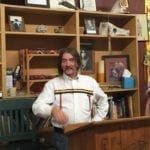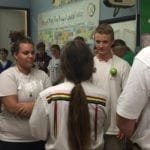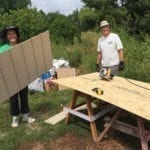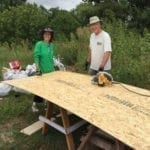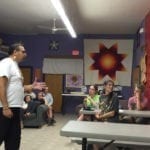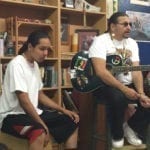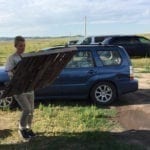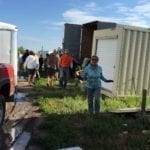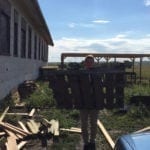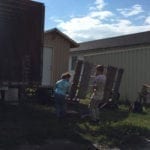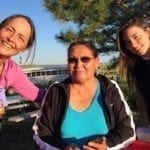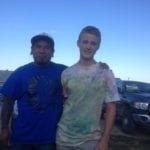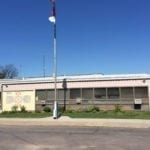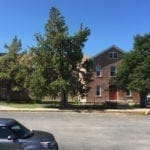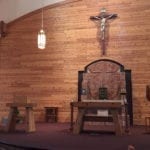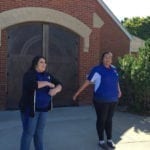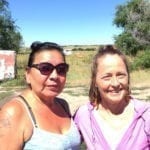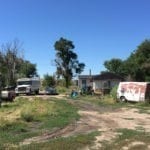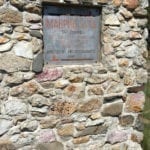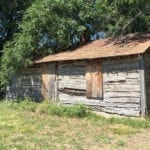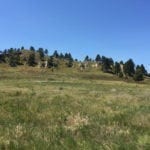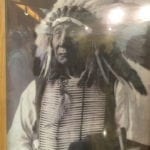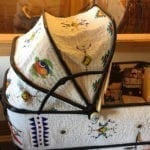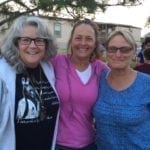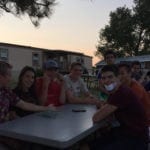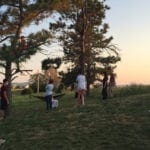Handcrafting High School: Year 2, Month 1: Re-member
I’m going to depart a bit and tell you about what we learned. I think it is the best way for you to get a feel for the profound benefits of exposing young people to this sort of service project where there is service directly to a community, field trips in the community, and talks from members of the community. Talks given by members of this community, while you are volunteering in it, that focus on issues the community is dealing with and has dealt with, are educational in a way no other academic situation could be. It leads to deep learning that becomes a part of what an individual understands to be true for these people, and it gives insight into how varied the world is and how opportunities in it are based on the circumstances of someone’s birth.
Before leaving we watched videos and read articles and books to learn what we could about the situation at the Reservation. We volunteered on the Reservation. After we left we discussed it and synthesized what we learned. The synthesis is important to learning. The synthesis, by the way, purposefully took place in Custer State Park, more on that at the end.
In structuring this I will tell you what we did each day. If we listened to somebody speak, I will include the notes I took from that talk. It is second nature to me to pull out a piece of paper and a pen when someone is talking. I learned a long time ago that even though I think I will remember later, I don’t. I am leaving my notes in a similar fashion to how they are written. At the end, I will share with you an essay Sean and I wrote. Much of the text in it comes from the Sean. I did prompt him occasionally. I am including this essay so that you can get a feel for how this experience profoundly moved my teen, and how I used the experience to help him think through and articulate what he experienced. I also used the experiences from this week to help him make connections to the world as a whole. I didn’t want him to think what he saw was just occurring locally on the Reservation, and I wanted him to come to an understanding of how federal, state, and local laws and policies, many of which are often voted on, can affect people now and in the future. For Sean, this was also part of his year spent focusing on politics.
Day 1 – 8/15/2015: Check in at Re-member
We woke up very early and spent most of the day driving. We passed through the states of Colorado, Wyoming, and Nebraska before taking a left and driving up into the southern end of South Dakota. The Pine Ridge Reservation is close to the border of South Dakota and Nebraska. You pass through the town of Whiteclay, Nebraska before driving into South Dakota. Whiteclay is a small, dusty town with people sitting outside of the grocery store and liquor store either drinking or passed out. Here is a link to the documentary, Battle for Whiteclay, which was made about the situation there, https://www.youtube.com/watch?v=HDAdhOxuTwk.
Late in the afternoon, we arrived at Re-member, which is located on the Pine Ridge Reservation.
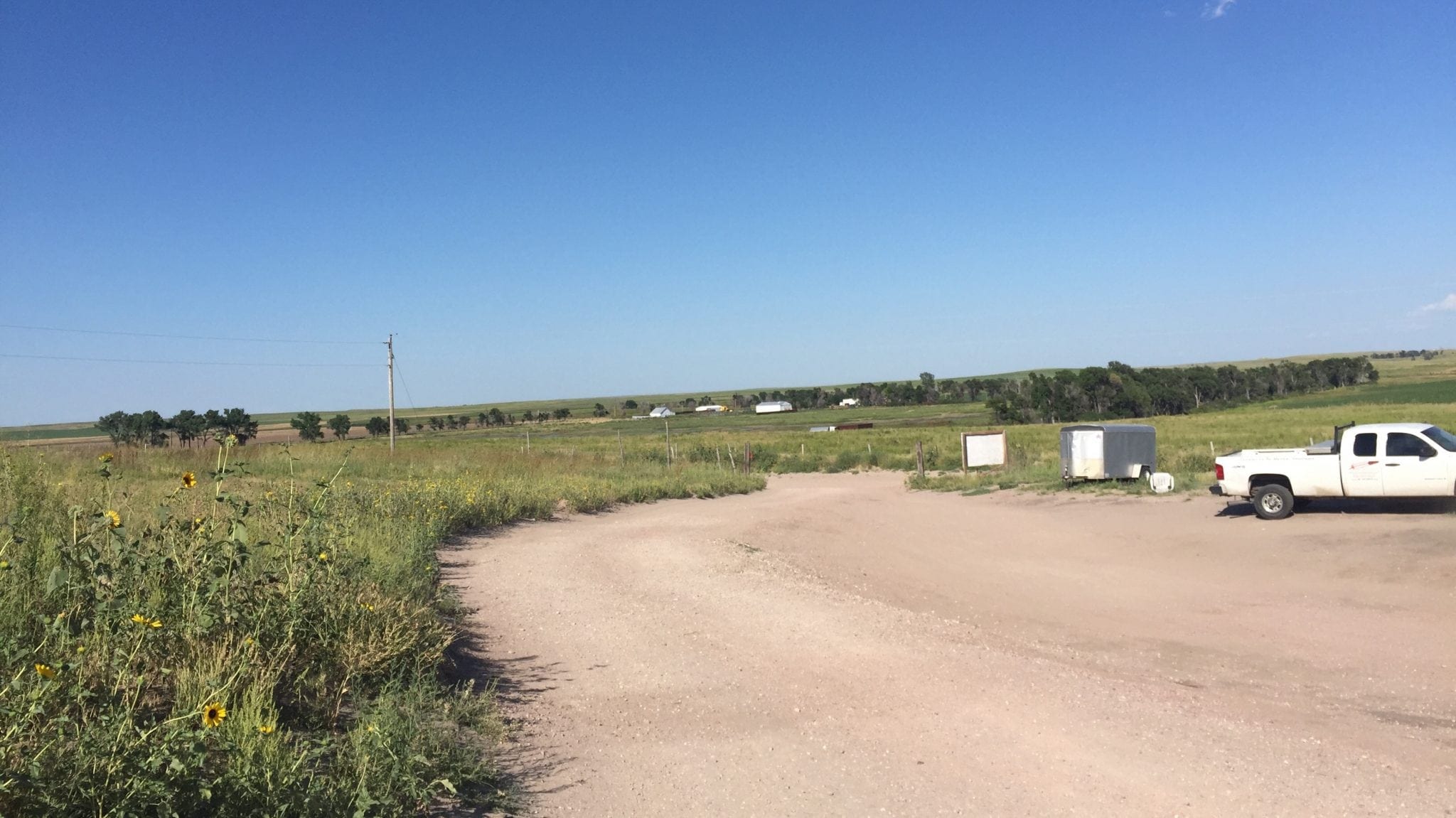
This is a view from the area where we stayed. There was a good-sized group of us staying here. I didn’t count, but I think there were 50 or 60 volunteers.
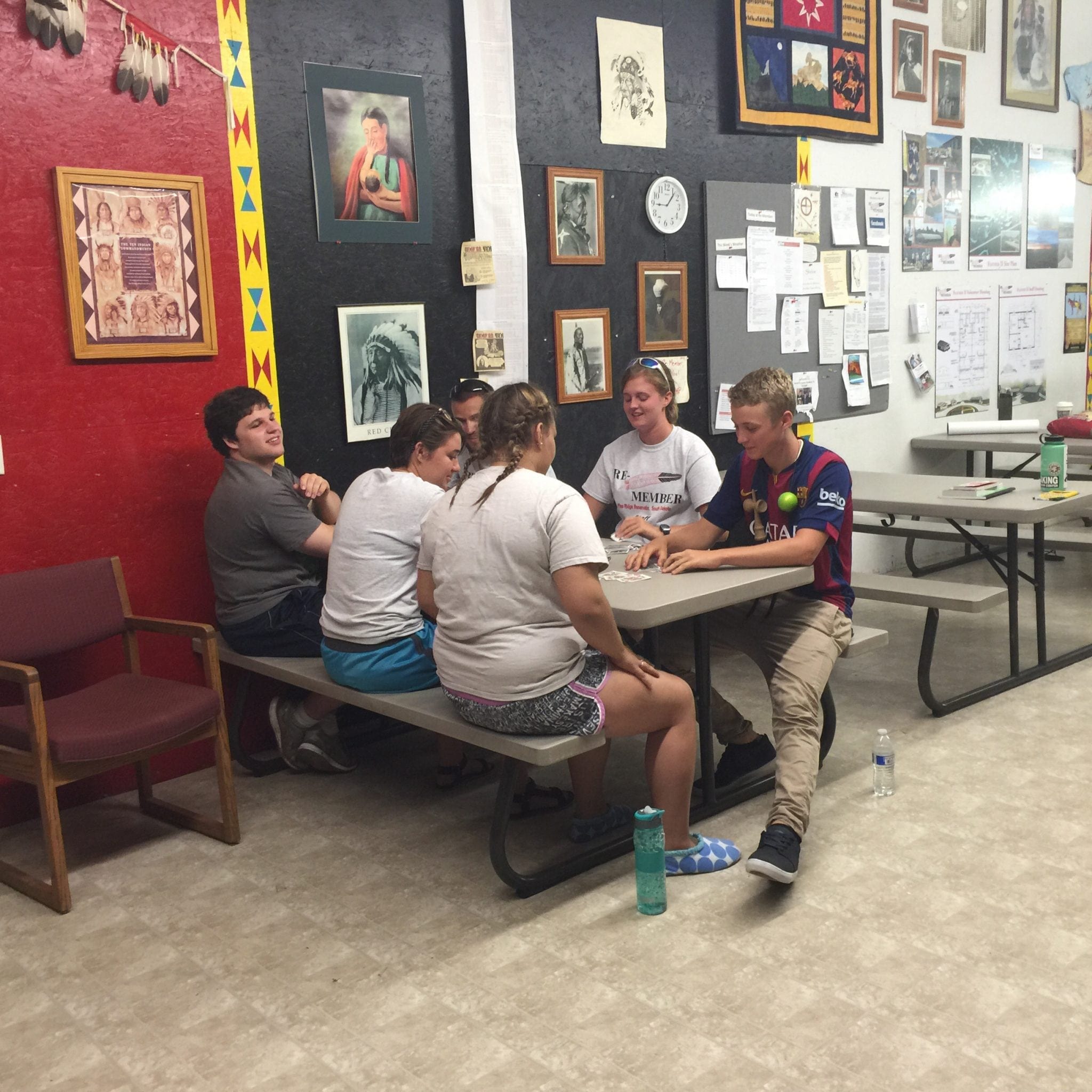 This is the common room. There is also a dining room and a girls’ sleeping area with bunk beds and a boys’ sleeping area. It was reasonably comfortable, and the food was pretty good. I had to go vegetarian for the week. Soon after arriving we were divided into groups of four or five. Each member of our group was separated into a different group. This was the group we would work with, including doing chores together. It is a good idea to divide family groups up. It leads to more mingling and interaction among the strangers who were volunteering together. My group was assigned kitchen duty shortly after we arrived, and it was off to the kitchen for me.
This is the common room. There is also a dining room and a girls’ sleeping area with bunk beds and a boys’ sleeping area. It was reasonably comfortable, and the food was pretty good. I had to go vegetarian for the week. Soon after arriving we were divided into groups of four or five. Each member of our group was separated into a different group. This was the group we would work with, including doing chores together. It is a good idea to divide family groups up. It leads to more mingling and interaction among the strangers who were volunteering together. My group was assigned kitchen duty shortly after we arrived, and it was off to the kitchen for me.
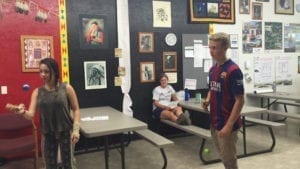
Day 2 – 8/16/2015: The Sanctuary, Wounded Knee, Red Feather, Keith Janis
The first day of our stay was spent learning some of the history, visiting the Badlands, and listening to Keith Janis speak.
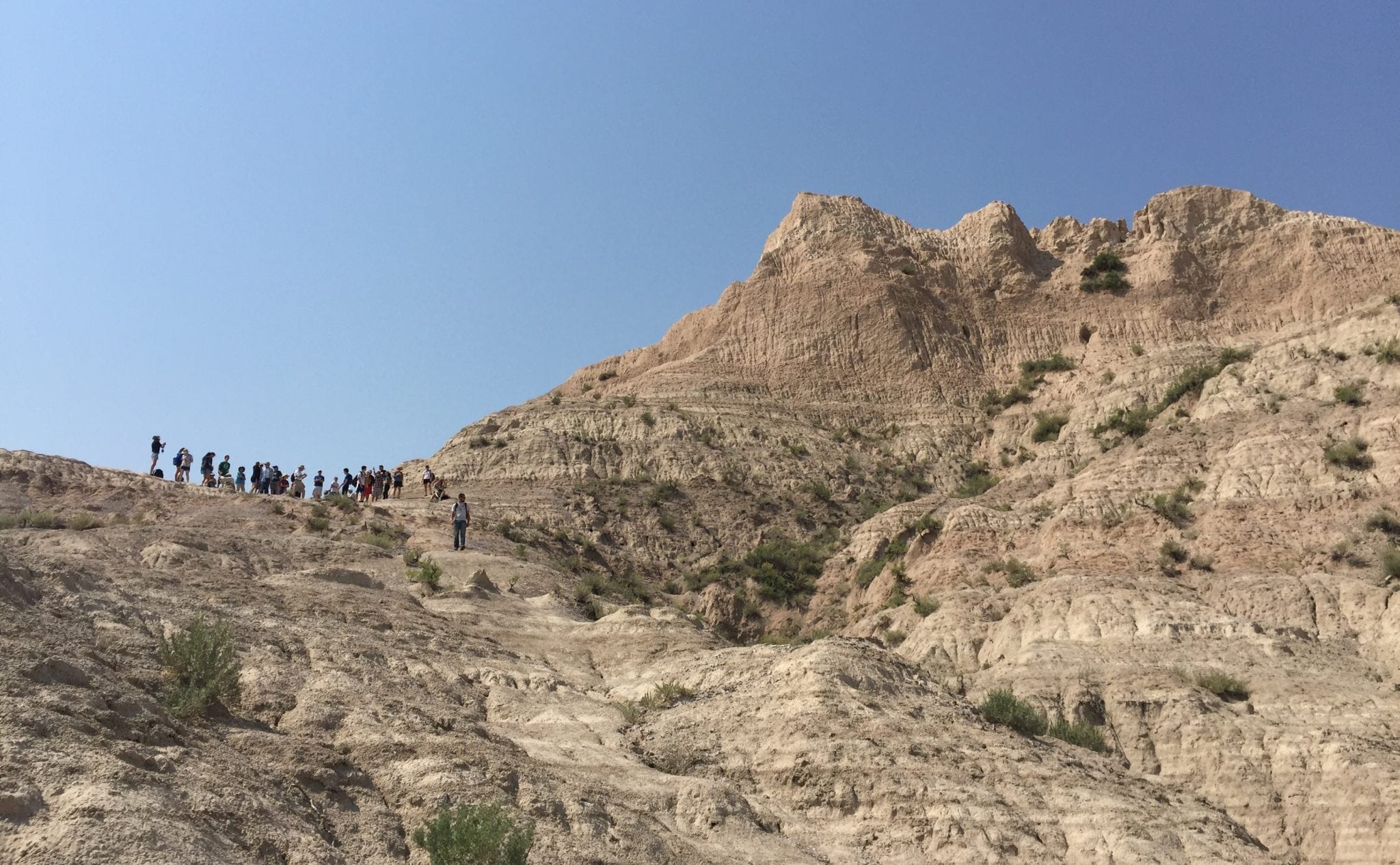
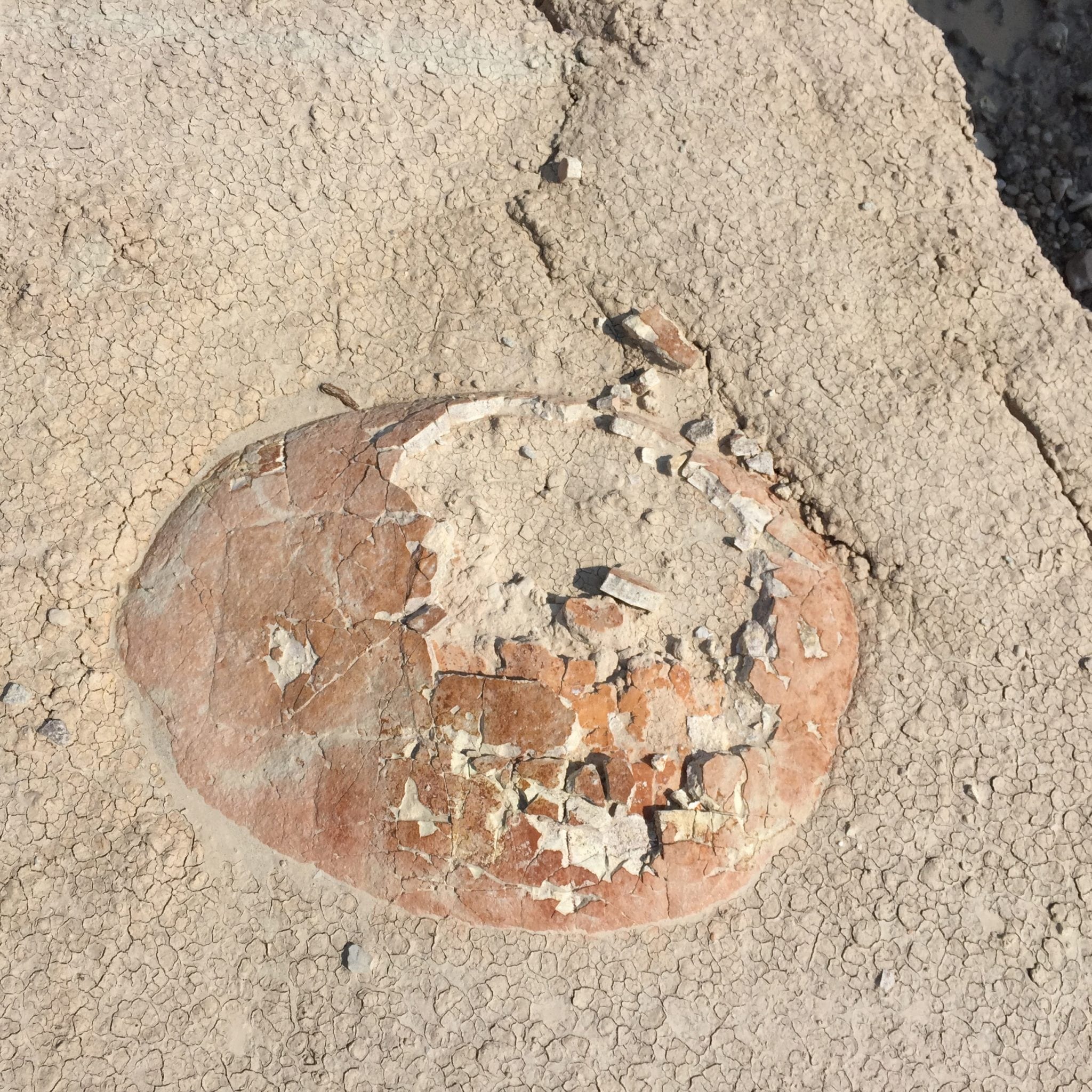
This is a fossilized turtle shell
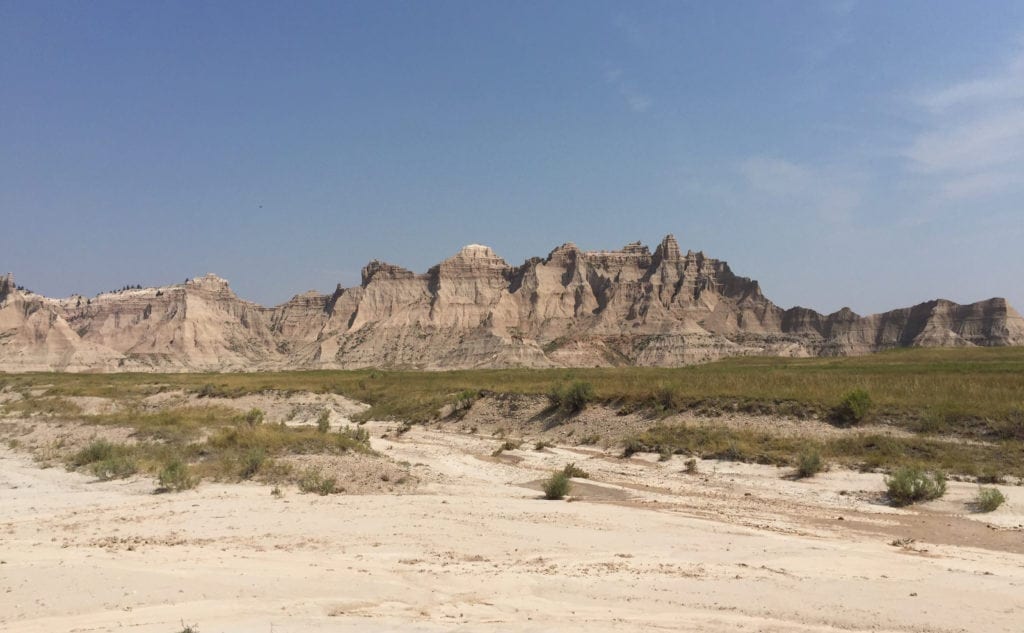
This area is called The Sanctuary. The entire group laid or sat down to meditate with the purpose of connecting with the land. It was a wonderful way to start. I happened to lie down next to ant hill. The ants began to crawl on but never bit me. They tickled.
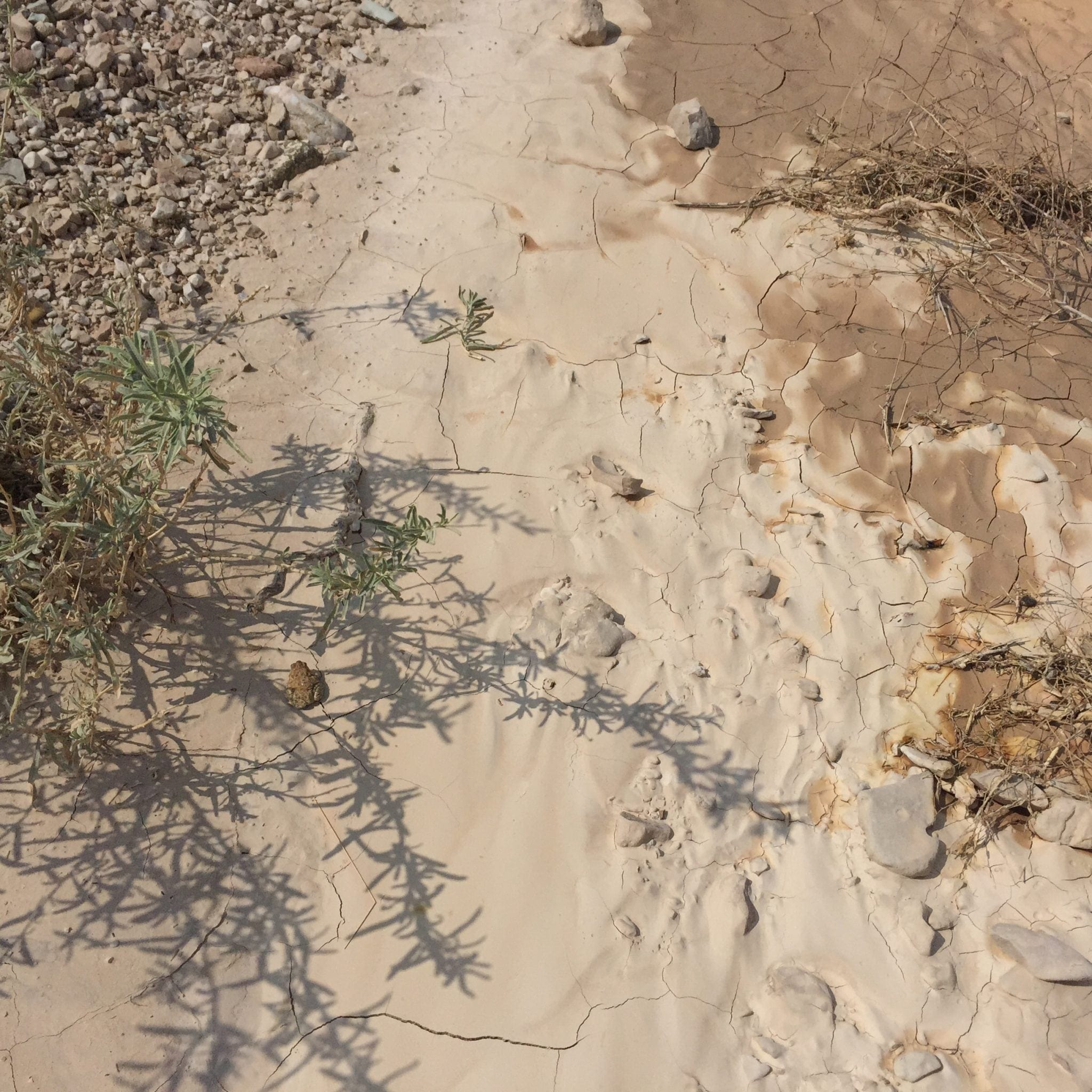
This little frog hopped by.
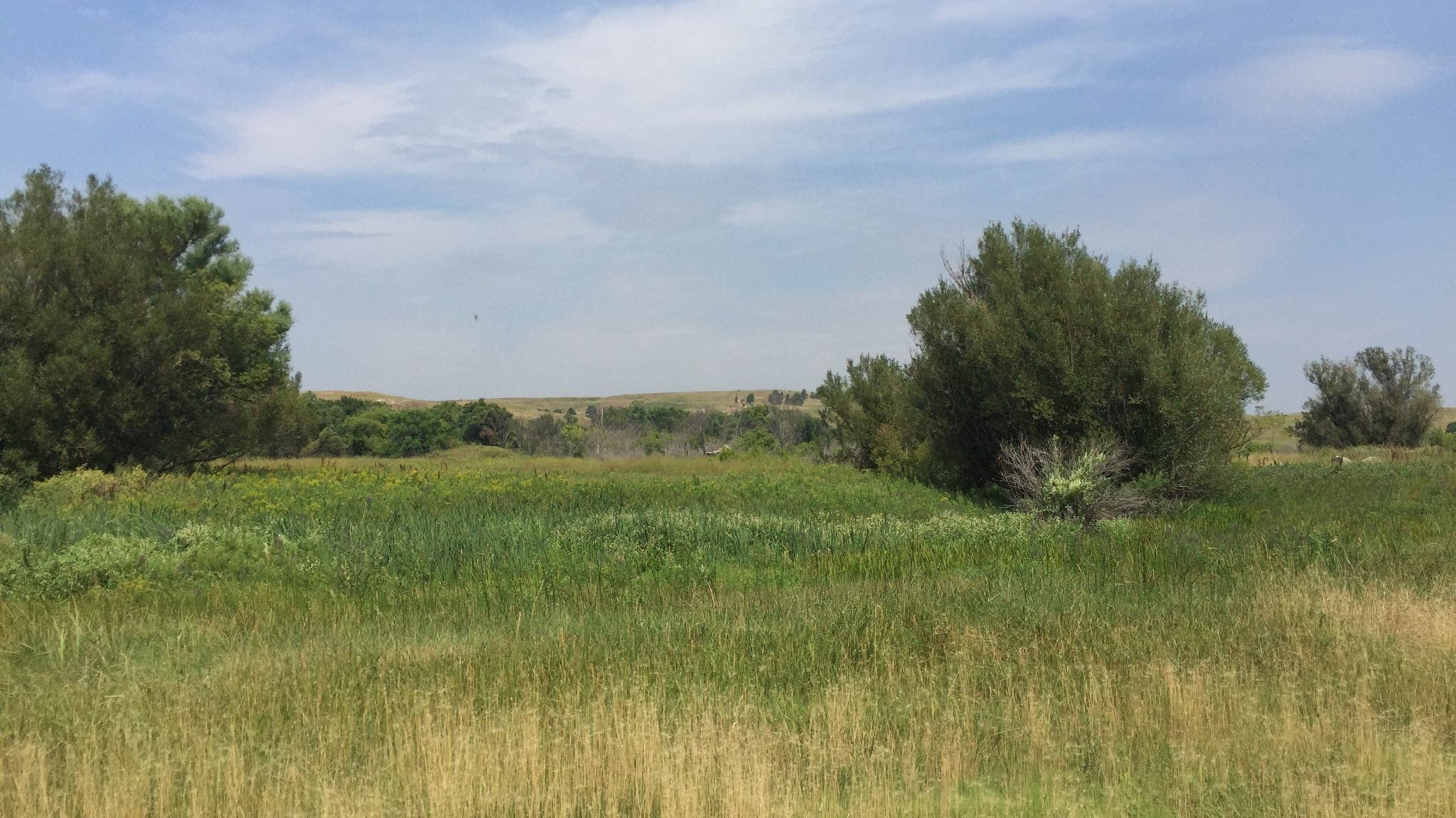
This is where the Wounded Knee Massacre occurred.
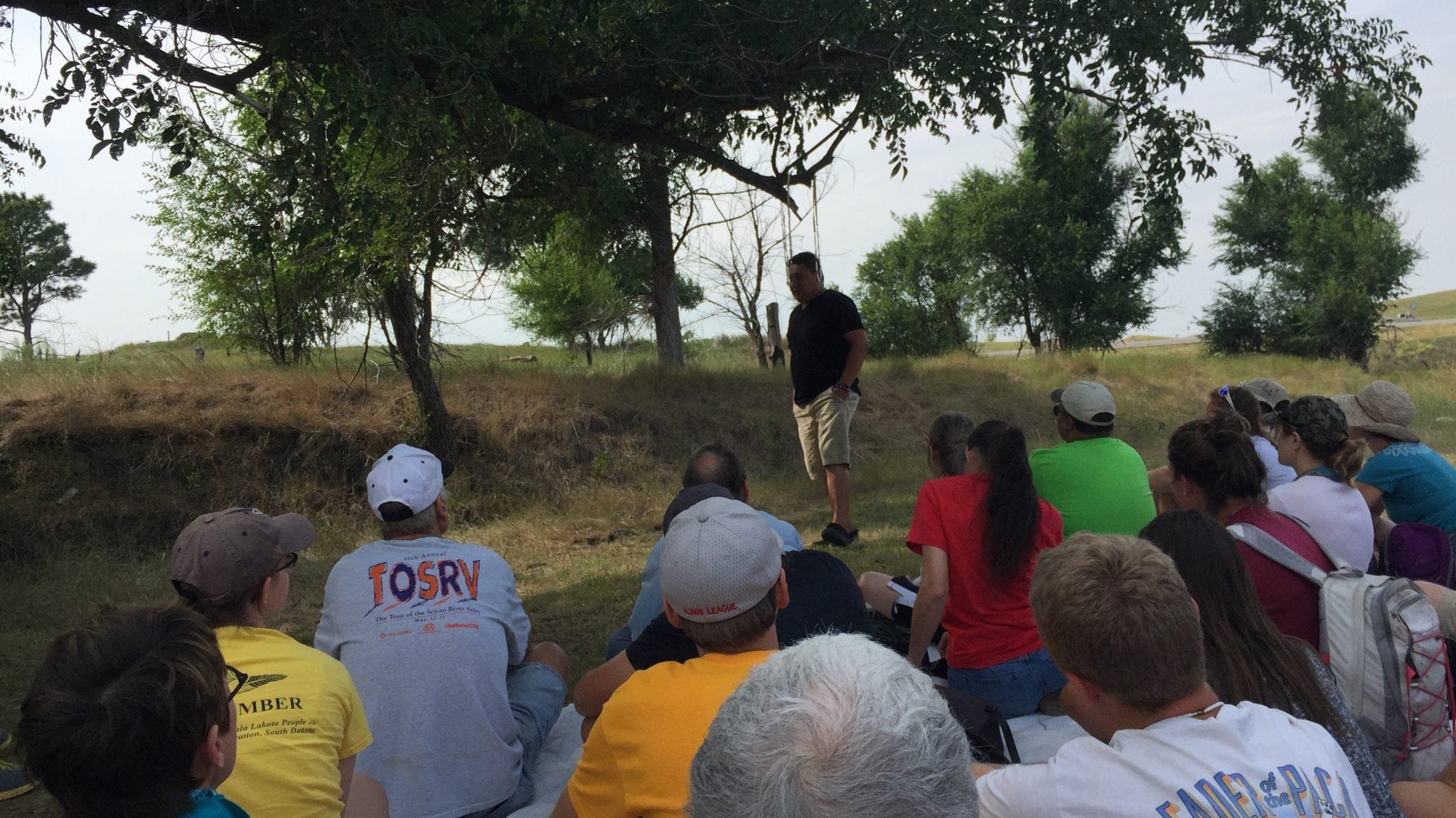
We listen to a talk about the Wounded Knee Massacre. I am sorry to tell you I cannot find the speaker’s name anywhere in my notes. It was very different from the lesson learned in school, unless you count Sophia and Sean, who are both homeschooled. This is the first week of 10th grade for them. Here is a link I found online about the history, http://www.lastoftheindependents.com/wounded.htm. The massacre was thought to have occurred as a retaliation for a defeat Custer had experienced many years before. It was brutal, bloody, and senseless. If you wonder, as I think some people do, why the people living on the Reservation are still focused on these tragic incidents, then you have most likely never been to the Reservation. The treatment of Sitting Bull and his followers was indicative of things to come. It is hard to describe with only words and pictures what we saw and heard over the next few days.
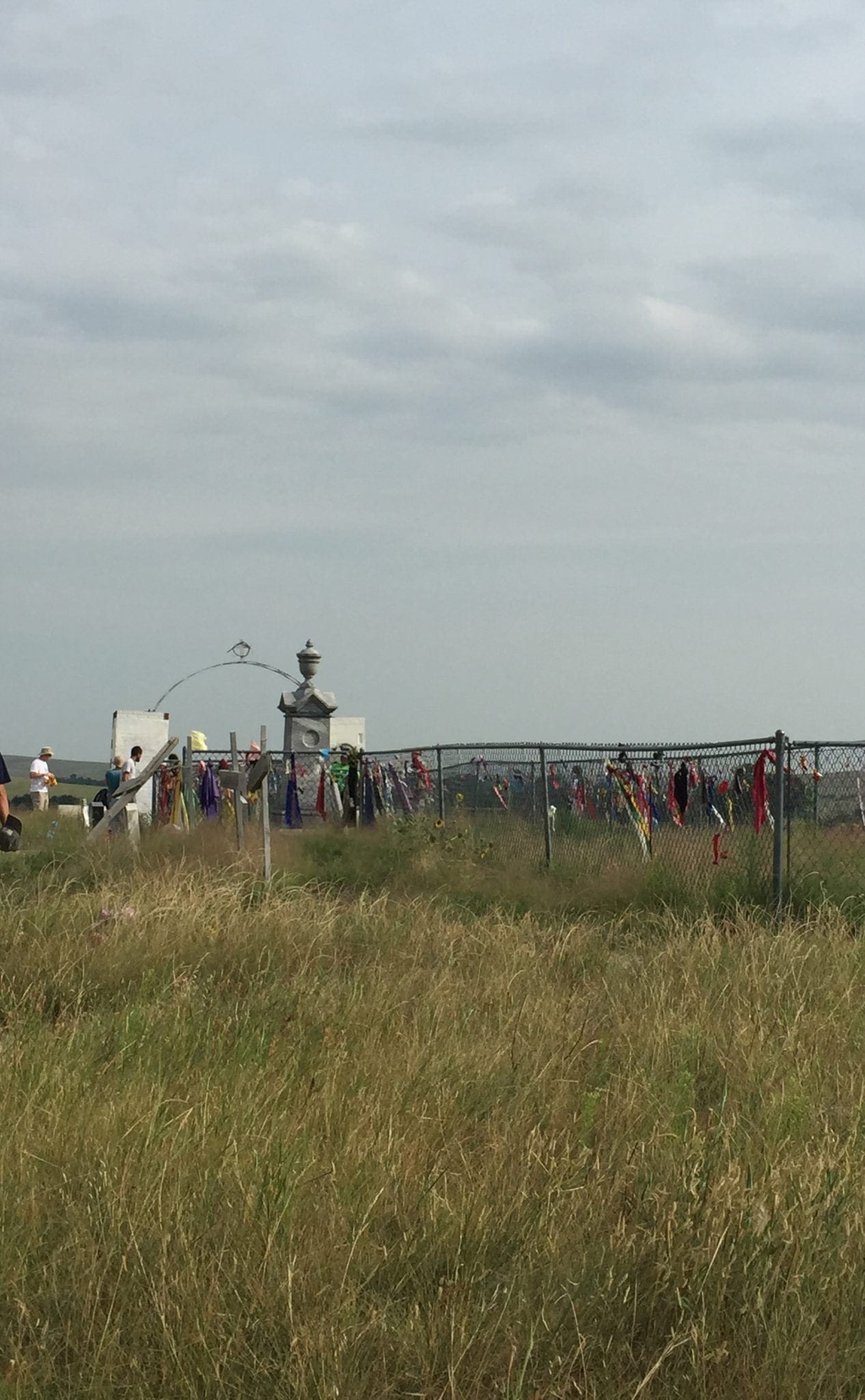
Across the road from the site of the massacre is a cemetery.
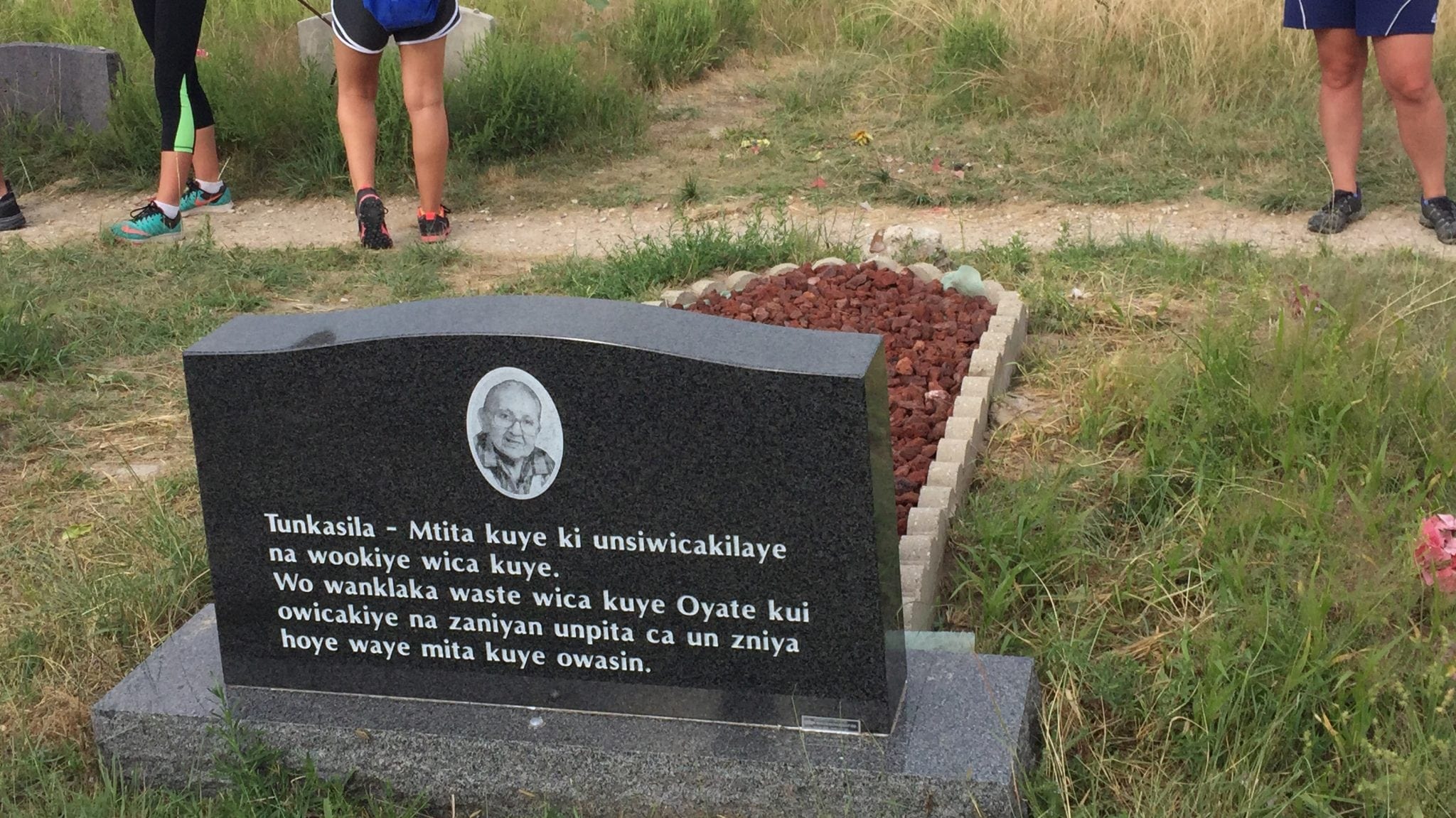
The people killed in the massacre were buried in a mass burial site piled on top of each other. There have been others buried here as well, including ancestors of survivors of the massacre.
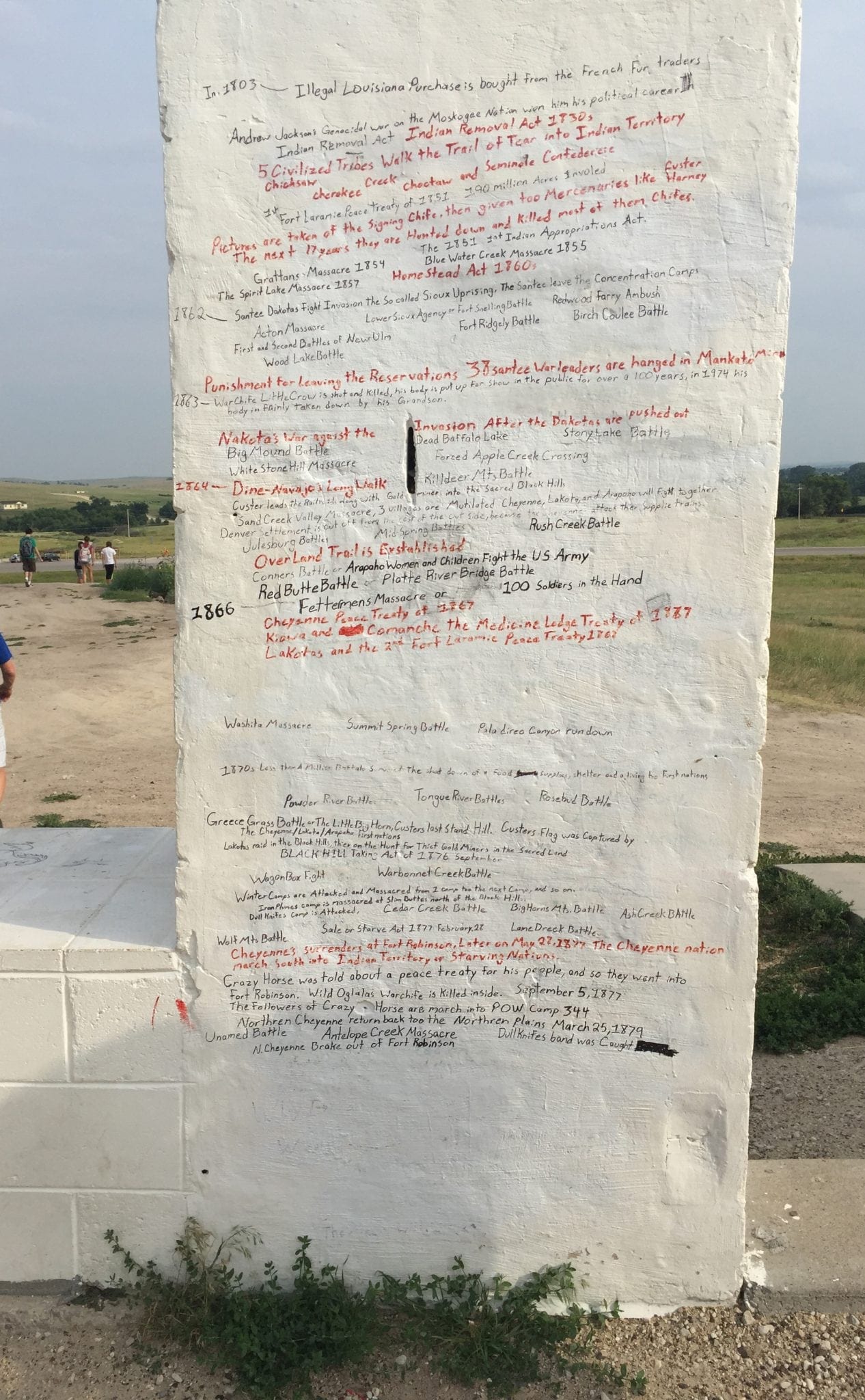
This is a list of some of the acts of genocide committed against the Native Americans.
Notes from Talk by Keith Janis: Keith was really broken up about the recent epidemics of suicides.
- The tribes that form the great Sioux nation are the Lakota, Dakota, Nakota, and Wajajo – the great Sioux nation was made up of nomadic tribes that followed the Buffalo.
- The Lakota’s ancestral heartland was the Black Hills. The Black Hills were taken from them, because gold was discovered there.
- To this day, based on the Indian Termination Treaty, Native Americans are still considered prisoners of war, which make Reservations prisoner of war camps. The Reservation was a prison designed to get rid of the Indian problem. This is what led to the Battle of Little Big Horn.
- The Sioux Nation calls their homeland Turtle Island.
- Crazy Horse, Bigfoot, and Sitting Bull were all assassinated by the Bureau of Indian Affairs. In addition to killing these leaders, legislators at about that time instituted a policy of killing Buffalo to starve Sioux Indians. At the same time it was illegal for Native Americans to be off the Reservation. The penalty for native people who were caught off the Reservation was beheading. People could earn three dollars per Lakota who was killed. (Cormac McCarthy wrote a heart-wrenching and superior work of historical fiction called Blood Meridian focused on this issue.)
- There were few buffalo left, and on the Reservations people were starving with only mice to eat. At this point, they started the Ghost Dance, which was a spiritual movement designed to bring back the Buffalo Nation. This was led by a person claiming to be a prophet who received some support. It was not unilateral support. As the great Sioux nation was a large group of people from many different tribal groups with many different allegiances, they did not all follow or agree on one path.
- The annual household income today on the Reservation is $5500. There is a high rate of diabetes, a high rate of infant mortality, and a high rate of youth suicide. In fact there had been three youth suicides in the past days, with the president of the tribe calling for a state of emergency. Along with the suicides, there is an increased rate of alcoholism and an increased level of poverty, all caused by historical trauma that to this day is unacknowledged by most of the community in the United States.
- The organization Re-member at 17 years old is the longest operating NGO on Pine Ridge.
- Can you imagine your daughter at 18 years old committing suicide instead of going to college with her 3 best friends? Our first speaker lost his 12-year-old granddaughter to suicide. Most of the people committing suicide are little girls. Something has to be done about these little girls thinking they don’t want to live this life.
- Historical trauma were things like forced sterilization, smallpox infected blankets, Gatling guns being used on unarmed people, children taken away to institutions where they were raped and purposefully separated from their culture. Even today the academic standards in reservation schools teach children history about the founding fathers, and the freedom and rights given to all Americans. This is untrue. Not all people experience the same rights and freedom or have the same opportunities.
- Between 1/15 and 8/15 there were 29 suicides committed by children on Pine Ridge. It is only one reservation. Over 140 children on seven reservations committed suicide during this time, and there were another 450 children who attempted to commit suicide but were saved through immediate intervention. This is in a state with slightly more than 1 million people.
- 28,000 children on reservations have committed suicide in 10 years. If these children were white it would be considered a national epidemic.
- Michelle Obama tried to address the epidemic of youth suicide saying the Spirit is not broken, but not much else has happened to address the issue.
- As you look around the Lakota Reservation you realize not much has changed. There are people without houses and no running water in trailers. It has become difficult to move off the Reservation or improve their houses even today, because banks will not give native people loans.
- While we were there a nine-year-old committed suicide. Can you imagine a nine-year-old not wanting to live any longer? It is heart-breaking.
- It wasn’t until 1973 that the boarding school era ended. This was the forced institutionalization of children. At the boarding schools speaking a language other than English or running away were severely punished. (There would be more on the boarding schools in a couple days. I will go into more details then.) Rape from staff members was common for both males and females. This brutal treatment led to the formation of AIM = the American Indian Movement, which started at Wounded Knee to walk on Washington.
- The government killed 90 Native Americans, AIM members, in the early 1970s.
- This bitterness and isolation leads to teen suicides.
- People with European ancestors are not confined to the Reservation –> everything other Americans have is from the displacement of indigenous people –> the work available to Native Americans is shoddy. Shabby and desolate areas were chosen for reservations in locations designed to fail, while prime locations were taken from them –> this was done with malicious intent in an effort to disenfranchise and disempower people who could not fix the system.
Day 3 – 8/17/2015: Blair skirting trailers, Will Peters
Today was a work day. Re-member has several projects going at the same time. The small group I was in went to fix the skirting on a trailer. We did work with other groups sometimes.
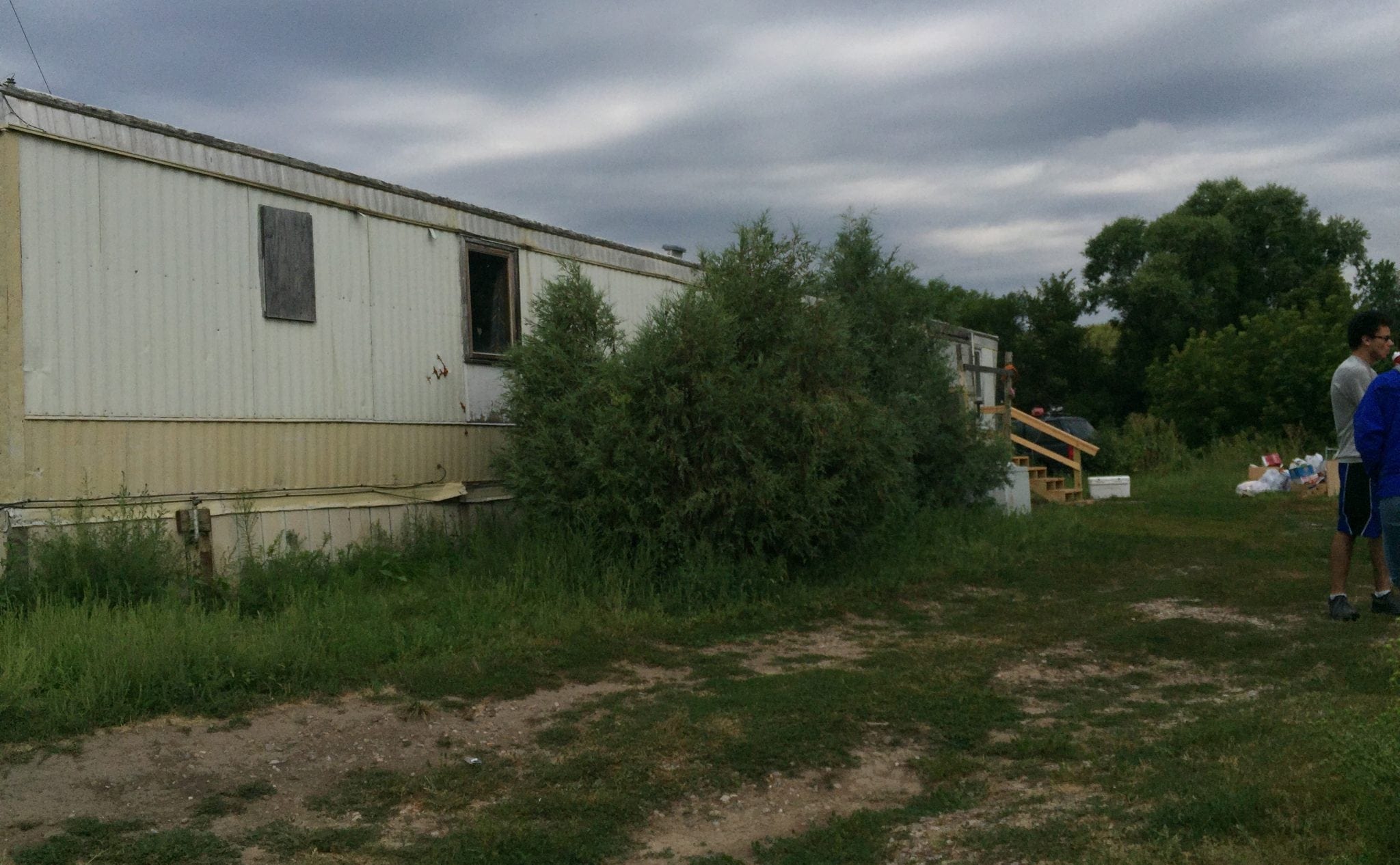
The trailer was in bad condition. I learned these are FEMA trailers built for people in the aftermath of Hurricane Katrina. There is a huge difference between weather conditions in New Orleans, Louisiana and Pine Ridge, South Dakota. When I looked under the trailer there was water dripping. Most people do not have running water to their trailer. It is considered a luxury. There is a problem using plumbing designed to work in New Orleans in Pine Ridge. The plumbing isn’t design to withstand the successive freezing and warming the plumbing experiences during the winter in Pine Ridge. So the water going to the trailers leak, a lot. If you’re wondering what the people who have no running water do, the water is delivered to them. We would consider the amount of water to be a small amount, 28 gallons a week. It is supposed to be delivered regularly, but the delivery is sporadic. For those people who do have running water, that is problematic as well. The government of South Dakota allowed a uranium mine to be built at the headwaters of the river that runs through the Reservation. Uranium mining releases toxic, carcinogenic pollutants into the water. The whole situation is a mess. Can you even imagine in the year 2015 living in a structure with your family, your children, that has either no running water or water known to be toxic? You begin to get a sense for how and why this community, and especially the children in them, could feel that this country and its citizens don’t care what happens to them. (After Flint, I guess so. I wonder how many communities have similar crises.)
Notes from Talk by Will Peters: Will, a high school teacher, talked about Lakota ways. He directed most of the talk to the teens, close to half the group. They appreciated how he directly reached out to them. Will also brought along his grandson.
- Pine Ridge is known to be the poorest community in the United States. If you wonder what community is the second poorest, don’t. Poor is poor. It doesn’t matter if you’re the first poorest, second poorest, or third poorest, who cares. For native people humor keeps them from poverty’s despair. Will said he worries about the women, the kids, the elders. People ask why these groups, and not just native people, but why poor people are not more involved in politics and ideologies. Why don’t they vote? Why don’t the poor work to change people’s ideas and their minds? Because nobody’s got time for these things. The day-to-day struggle when you don’t have enough to eat, when you can’t take care of your family, is all you have time for.
- And for poor people and First People trust is hard, because there have been so many people, politicians, missionaries – all of these people came to the Reservation and made money and careers, and then left without fulfilling their promises. This becomes a problem for those people who show up and do want to change things and are sincere with their promises. There has been such an erosion of trust, it doesn’t feel worth it. It feels like it isn’t worth investing that trust in someone else.
- Child suicide on the Reservation has been back to back – one was a student who was still in elementary school – then there were six more suicides soon after. Part of the problem is that we need to listen to the kids; let them tell us what happened to them. In the face of all the poverty, suicide is the new way kids are dealing with the hopelessness of their situation. The best way for suicide prevention is that we listen, show the love, and show our capacity to care.
- Will pointed out that a teacher is nothing without students.
- Once the entire North American continent was called Turtle Island by the Lakota’s.
- Will discussed the Keystone XL pipeline. This came up several times while we were on the Reservation, with many native people saying they were willing to stand up and protest it being brought over/through native lands, and they were willing to die to stop it if need be. The Lakota we heard from felt that the Keystone XL pipeline being built across the Reservation would have been akin to more taking of their land by the government for corporate interests who care only about money and not about the people. One of the things we learned about the Keystone pipeline is that everything needed for it had already been built. The holdup for the Keystone pipeline being completed and operational is the 300 miles the pipeline needs to run through tribal lands. The United States government cannot just build a pipeline across native lands, although at that time it looked like they might. It is possible the fight is what kept it from being completed. The Keystone XL pipeline is another example, along with guns, the liquor industry, and energy drinks with alcohol in them, all of this is about the money. It has nothing to do with caring about the people. It isn’t just an indication the federal, state, and local governments and businesses don’t care about native people. It is an indication they don’t care about any people.
- We need to be honest with our kids and stop the racism, classism, sexism, and bullying. This is important for all young people, not just those who are poor. It is time for a war on poverty, illiteracy, and -isms. We need to eliminate sexism. Forget burning bras we should be burning men’s underwear, and let them see what it’s like to go without support. We need to teach young people to dream without fear. To teach them they can believe in their dreams and walk inside their dreams, that their dreams can honestly come true for them. Adults should view young people as sacred beings. The human race needs to stop destroying itself and this planet. We need the sacred beings to save it. Poverty causes people to tear each other down instead of supporting each other. The young people, the sacred beings, need to come together and support each other. There needs to be a change in the dialogue from suicide to talking about a reason to live. Adults need to advocate for these sacred beings with the purpose of supporting them and their dreams. We need to focus on giving them a reason to live. One of the biggest problems when we do not raise our children to believe in dreams and to fight for what is right and against injustice is that these young people become old people without having any concept about the quality of their life. They spent their entire life just thinking about surviving. This is called historical trauma.
- When Will introduced his wife he said something I love. He called his wife, “the other side of me,” and said he thinks of her like that because the two of them have been walking side-by-side together for many years.
Here is a short documentary Will is featured in, Dream without Fear, https://www.youtube.com/watch?v=4mlYIZpy1m0.
Here are some songs of his, http://walkthelinemusic.com/music/lakota-will-peters-memorial-song/.
Here is an article about the Nammy award he won, http://www.lakotacountrytimes.com/news/2009-10-06/Front_Page/2009_NAMMY_for_Reservation_Nights.html.
Day 4 – 8/18/2015: Blair building outhouses and bunk beds, Larry Powers
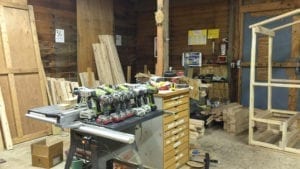
On the property with our dorm there were several shops. On this day I had the pleasure of working with Jerry. At each project there are one or more employees who are in charge. Jerry is in charge of the shop. We spent the day building bunk beds and the frames for outhouses. These are in high demand. You might wonder why. I did, so I peppered Jerry with questions about the project. The list below is what I learned.
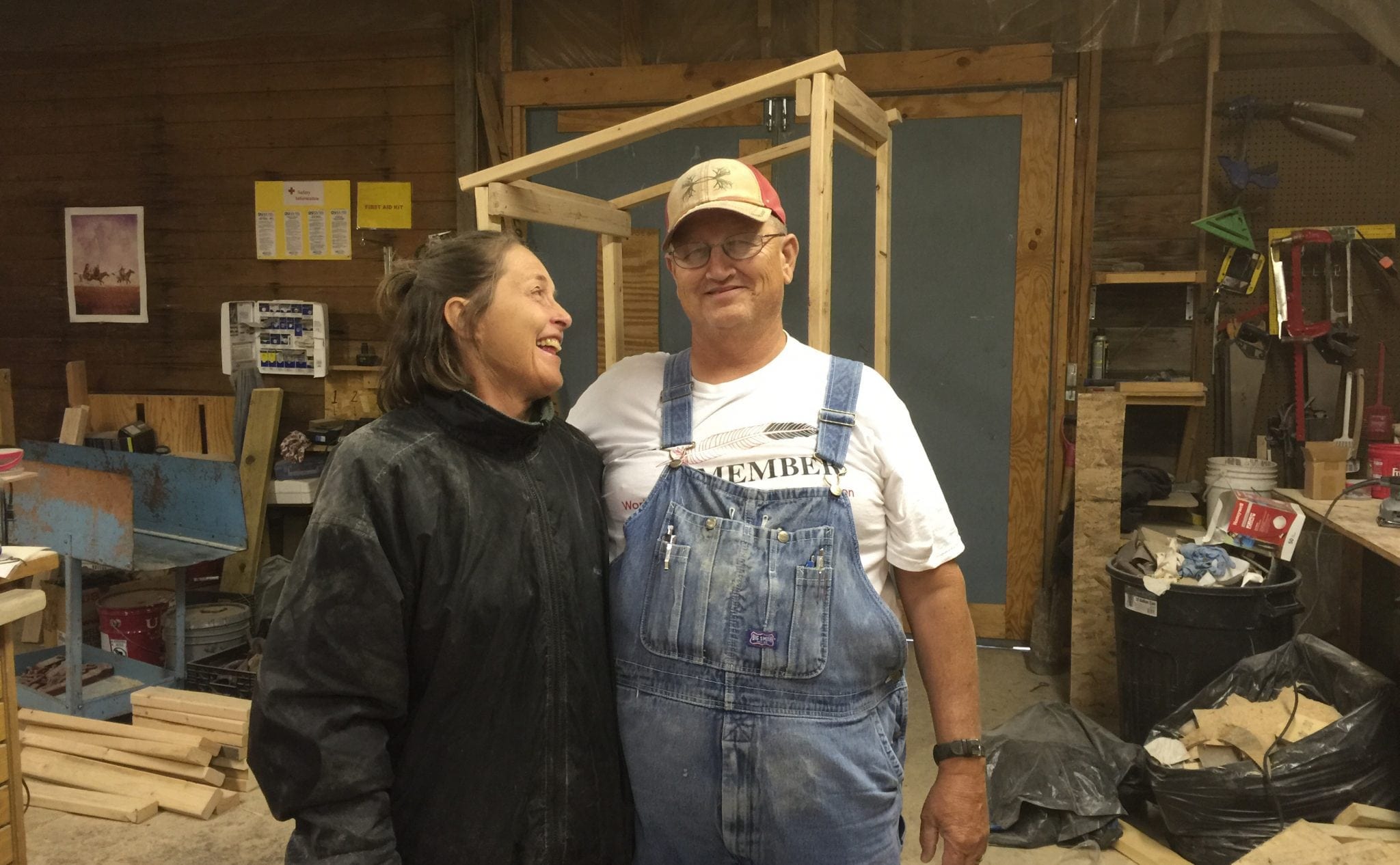
- Bunk beds: People sleeping in bath tubs. 8 year old children who have never had a bed to sleep in. Paralyzed woman sleeping on the floor with teens as the only people to help her. Jerry met a woman who had lived in a house for 40 years, living on 300$ a month to pay for rent and heat, one of these bunk beds was the first bed she had slept on in her life.
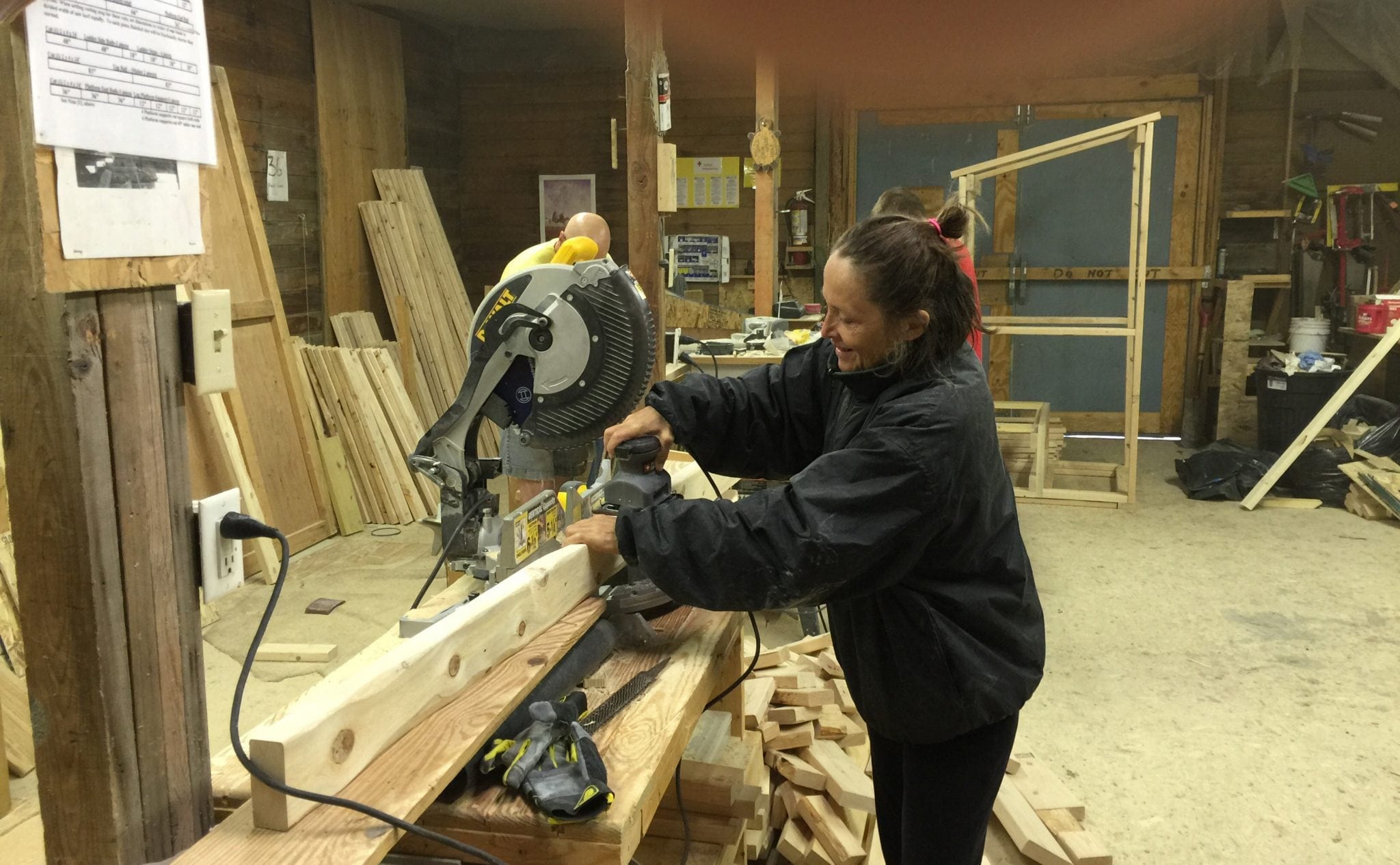
- Outhouses: There are water table issues, and problems with the plumbing at trailers. Most trailers are not insulated. Something I observed when I worked on skirting the trailer. Trailers built by FEMA for Katrina then sent to this extreme environment – electric not gas. What if you can’t pay your electrical bill? They turn the electric off, even in sub-zero temperatures, and pipes burst inside the house/trailer. Donated trailers in substandard conditions.
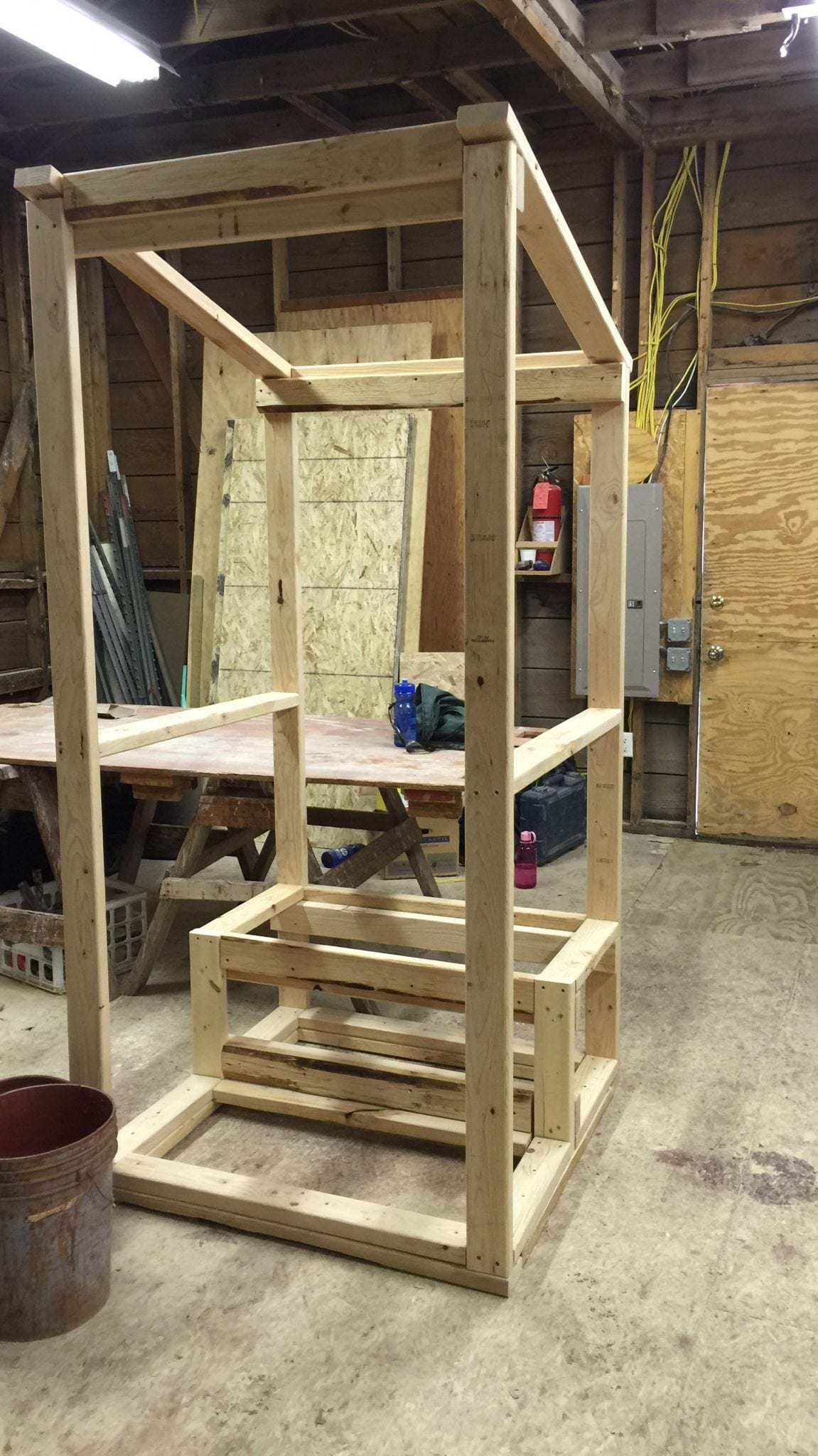
- Uranium mine at the headwaters above the Reservation – arsenic -radon. This is the tribe’s water source. Those communities that do have water, have high rates of cancers associated with radiation poisoning.
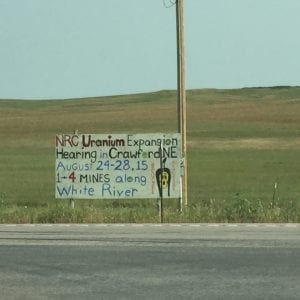
There is a documentary about this, http://www.cryingearthriseup.com/ and an article http://indiancountrytodaymedianetwork.com/2015/03/03/its-mother-earth-vs-father-greed-new-pine-ridge-uranium-documentary-159451
- Ranches and towns outside of the Reservation have non-toxic water available to them. Why? Voting and dollars in these predominantly, white communities.
- Black mold in basements of houses with people sleeping in them – for a veteran and her children. She came home from Iraq after spending 4 years in the military. She now lives with her children, sleeping on the floor in her mother’s basement.
- For those with no running water: 28 gallons a week is delivered, but sometimes the delivery is not made, and it is 2 or 3 weeks. Think about how much water you use in a week.
- Superfund site on tribal lands? Homeless?
- Indian Giver means you give something back not take something without sharing.
- You see trash in piles around the community. It is because there is no trash service and the cost of gas to get to the dump and the fees at the dump are prohibitive for most people.
Notes from Talk by Larry Powers: Larry is a spiritual leader. The bulk of his discussion was about issues related to that. I am sorry I did not take extensive notes on this day. I was feeling rather hopeless on this day. I felt like as much as I care, I could not make a difference, that the problem is too big. After Larry’s talk I sat in the dining room and talked to Jerry. He helped me to process it all, even though much of what he told me was distressing. It helped to talk about what I was seeing. If you don’t know it, and most don’t, there is another America in the midst of the one many of us live in.
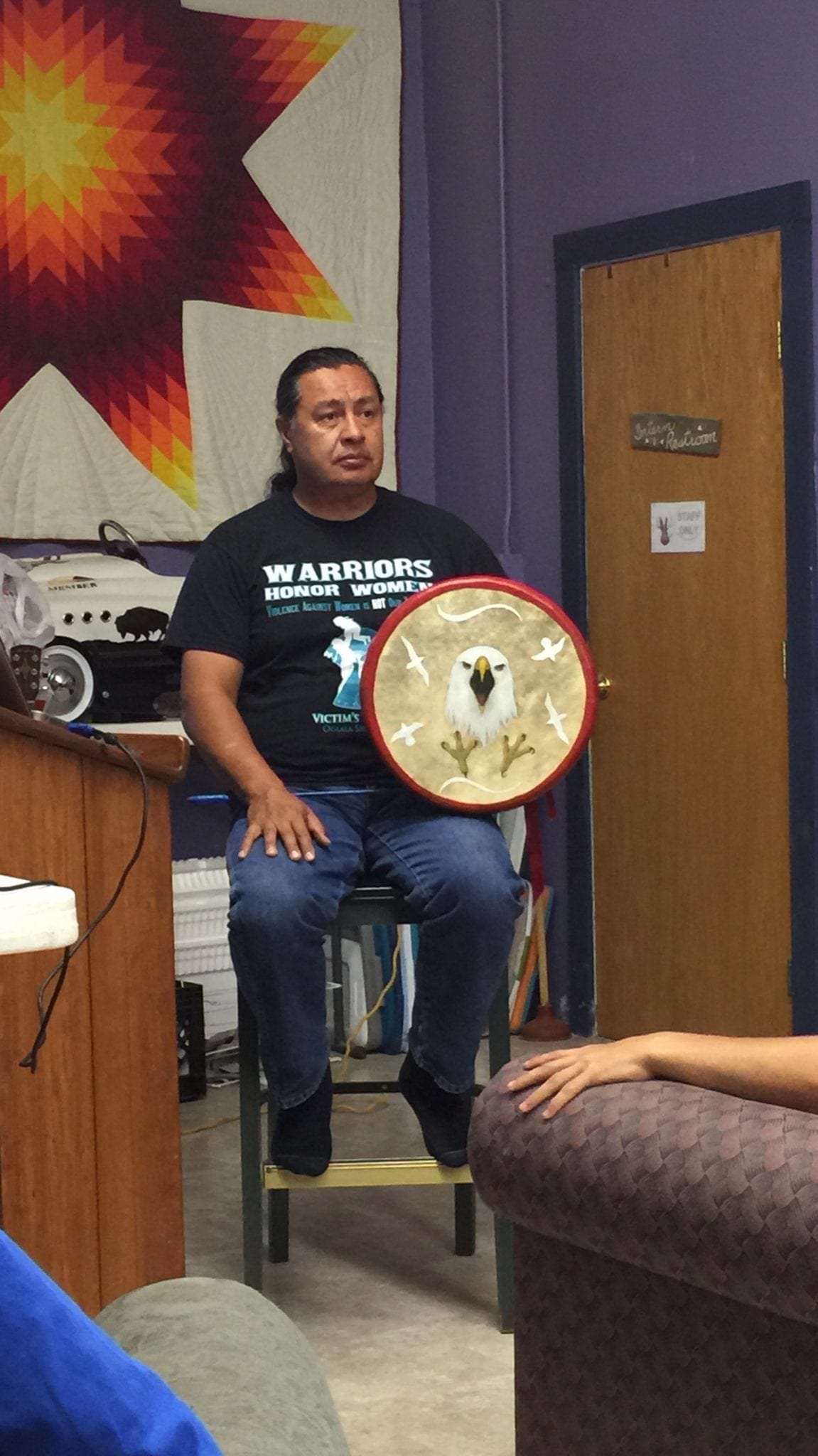
- Mohammed, Buddha, Jesus, and White Buffalo Calf Woman were all important prophets, https://en.wikipedia.org/wiki/White_Buffalo_Calf_Woman. Both Larry and Carol who spoke to us the next day made a point of telling us that unlike settlers to America, First Peoples had a female prophet. Both also told us sexism was uncommon among Native Americans before the European settlers came. Many tribes, like the Lakota, had female leaders. The European settlers were not used to dealing with female leaders. Often this led to tribes having a male member of the tribe represent them. These were not experienced leader, and the tribe would not necessarily follow these men. Over the years, however, this did lead to some of the sexist behavior within the tribe today.
- One of the most damaging policies from European settlers was Manifest Destiny.
- Larry went into what happened to the AIM movement. If you are interested in this I recommend the documentary Robert Redford made about Leonard Peltier, http://www.amazon.com/Incident-Oglala-Leonard-Peltier-Story/dp/B0001FVDI2
- Racism as a synonym for ignorance
- Who taught you language? Are you fluent? Is there a movement in your community to teach traditions to the young, and if so how effective is it?
- When you look at First Peoples (and enslaved people) you need to realize there has been a previous condition of servitude. This affects many of the attitudes and actions they take today.
Jerry is also a poet. This is a poem he wrote. 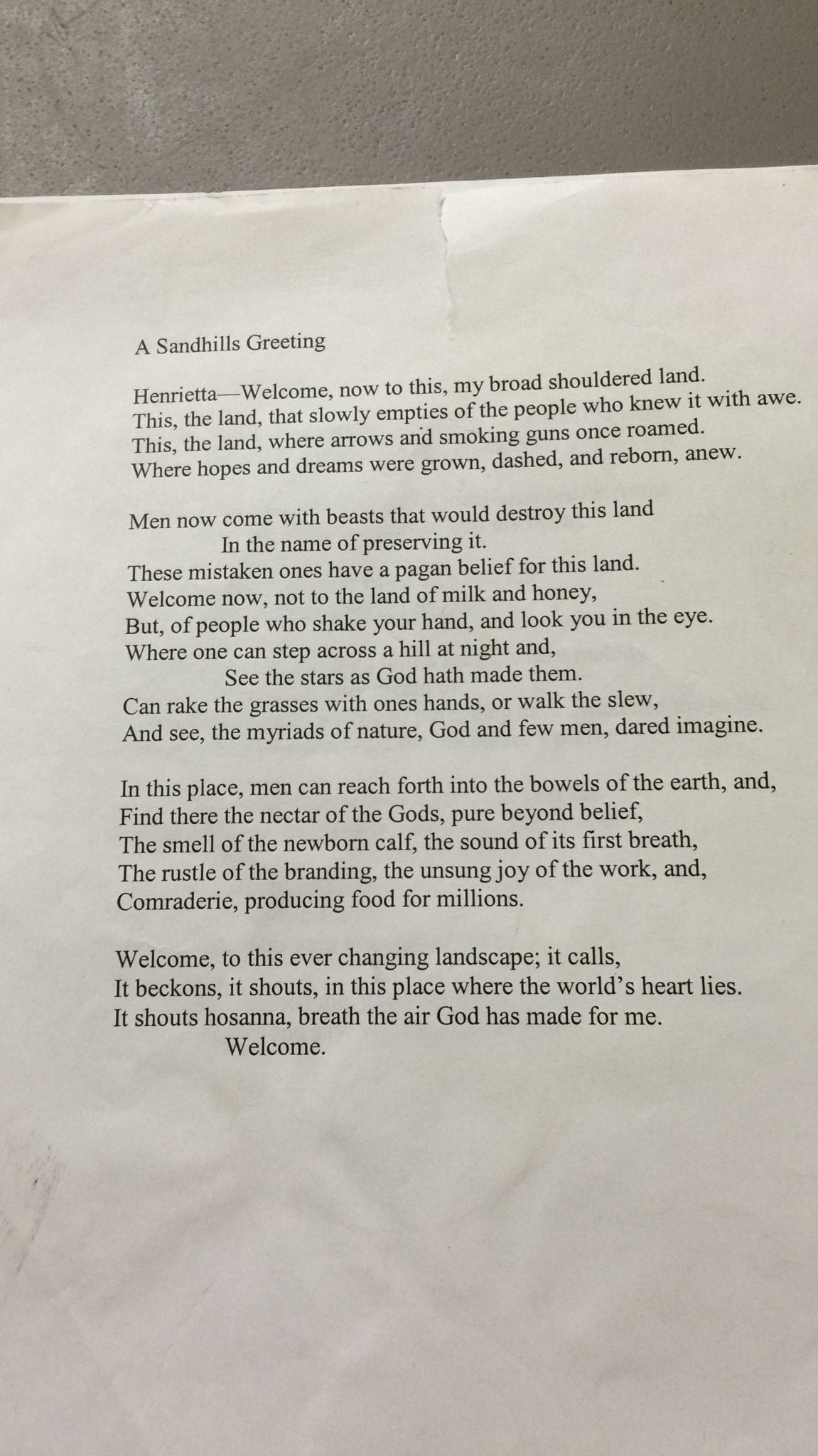
Day 5 – 8/19/2015: Blair and Sophia building a wheelchair ramp, handcrafted goods, Carol Iron Rope Herrera
Some days we worked with only our group, and some days we worked with multiple groups. Loading the trailers on the last work day was the closest my group would come to working with Sean and Michelle.
I never worked with Jim. Today I was assigned to build wheelchair ramps with Sophia.
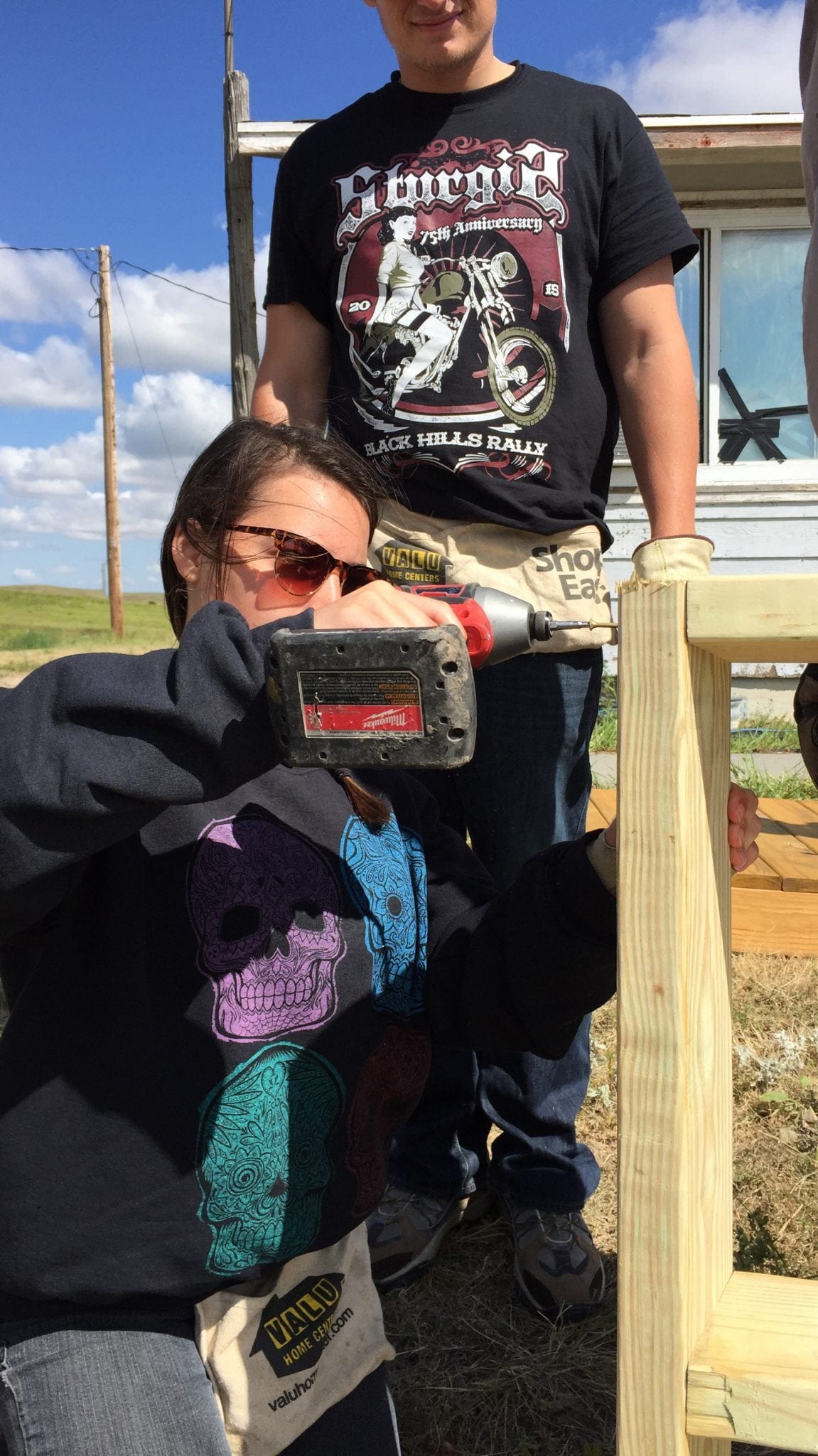
We got back to the dorms, cleaned up, and then got to work on a meal for people in the community. This was a meal the people in the community are invited to, and the volunteers at Re-member feed to the people who attend. I have no photos of this, because I was tired and busy. I managed to get my energy back in time to spend some money on the handcrafts displayed on the tables.
Here are two of the artisans who made jewelry we bought.
Notes from Talk by Carol Iron Rope Herrera
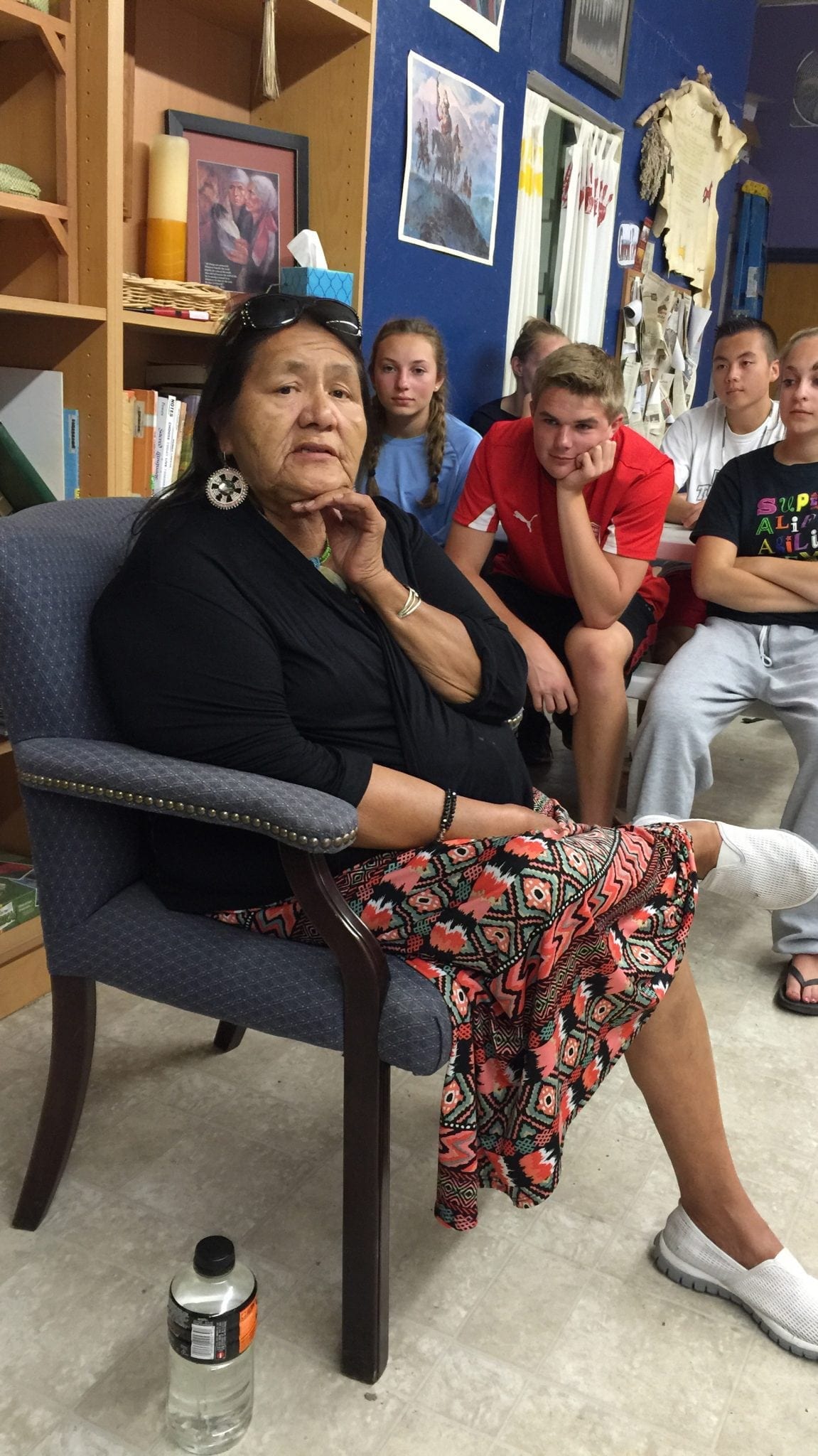
Carol has spent much of her life working to help children and their families. She is an educator and an administrator, and at one time was the coordinator of the Healthy Start program on Pine Ridge. These days she works for the organization she created called the Stoneboy Women’s Society, http://lakotasacredhoopcollaborative.org/. The society teaches traditional Lakota birthing ceremonies to Lakota women. She told us she was working on her Master’s degree. Carol talked to us about the boarding school experience.
- In native culture when a person’s hair was cut it meant someone died. The first thing that happened when the kids were taken away from their family to the boarding school was that their hair was cut. There was no explanation or attempt to help the children understand this was not because someone close to them had died. Many of these kids did not understand English so they couldn’t understand this was a cultural thing.
- At the boarding school it was forbidden to cry or speak in the native language.
- Carol Iron Rope Herrera told the story of an acquaintance or relative, I didn’t write which, who had been taken to the boarding school when she was five years old. The little girl would not stop crying. She was told repeatedly in English to stop crying or she would be punished, but she did not understand English. It was not until sometime later she was told what the intake people had been saying to her. Finally the intake person became so upset with her, the woman cut the tip of her finger off. When this made her cry even more the woman cut another tip of her finger off. Many times we were reminded of the historical trauma.
- One of the most disturbing things we learned was that even today kids on reservations are forced to learn history that glorifies the Christian faith. The people running these boarding schools were part of the Christian faith and the Europeans who came to the New World and set up a government that would do these sorts of things. If this sounds like these things were happening a long time ago, remember it wasn’t until the mid-70s the boarding school era ended. That’s not 1870 that is 1970s. The boarding schools destroyed the human knowledge and the methodology of how to raise a family. 25% of all people committed suicide while they were inside the boarding school; another 25% committed suicide once they were out; 60% of all people in the boarding school were raped. We heard a lot about the girls and females being raped, and I specifically asked about boys being raped. You hear less about it because of increased feelings of shame, but if 60% of all people in the boarding school were raped, it seems rape must have been common for boys taken to the boarding school. My guess is 60% is a low number since the rape of boys tends to go under-reported. At the age of 18, people were let out of the boarding school and expected to raise kids and live in a happy, well-adjusted family. They didn’t grow up in a family. They didn’t grow up watching parents do a good job taking care of their children. They didn’t learn these types of skills. It is unfair to expect a population of people forced into this situation to, as an entire group, have the skills needed to raise their children. They do not have the cultural competence needed.
- One of the things that happened in the boarding school was that name changes were forced on Native Americans. These name changes have done native culture, history, and people a great disservice.
- Things have improved but they have so far to go it can be hard to see. Especially if you’re only at the Reservation for a week as we were.
- A movie depicting what was done to Native Americans, that Carol thinks does a good job of it, is Soldier Blue. I remembered seeing it when I was about Sean’s age with my mother.
- Time and life are not linear; the past, present, and future is circular. Is important to understand equality is also circular.
8/20/2015 Day 6: Field Trip, Black Elk’s Cabin
On the last day we went on another field trip. We started by with a tour of the Reservation. These are the notes from the guided tour. We had lunch at a lunch spot run by an ancestor of Black Elk, called Betty’s Kitchen. Several of us then hiked down to Black Elk’s Cabin. After we packed and got ready to leave in the morning for the rest of our journey.
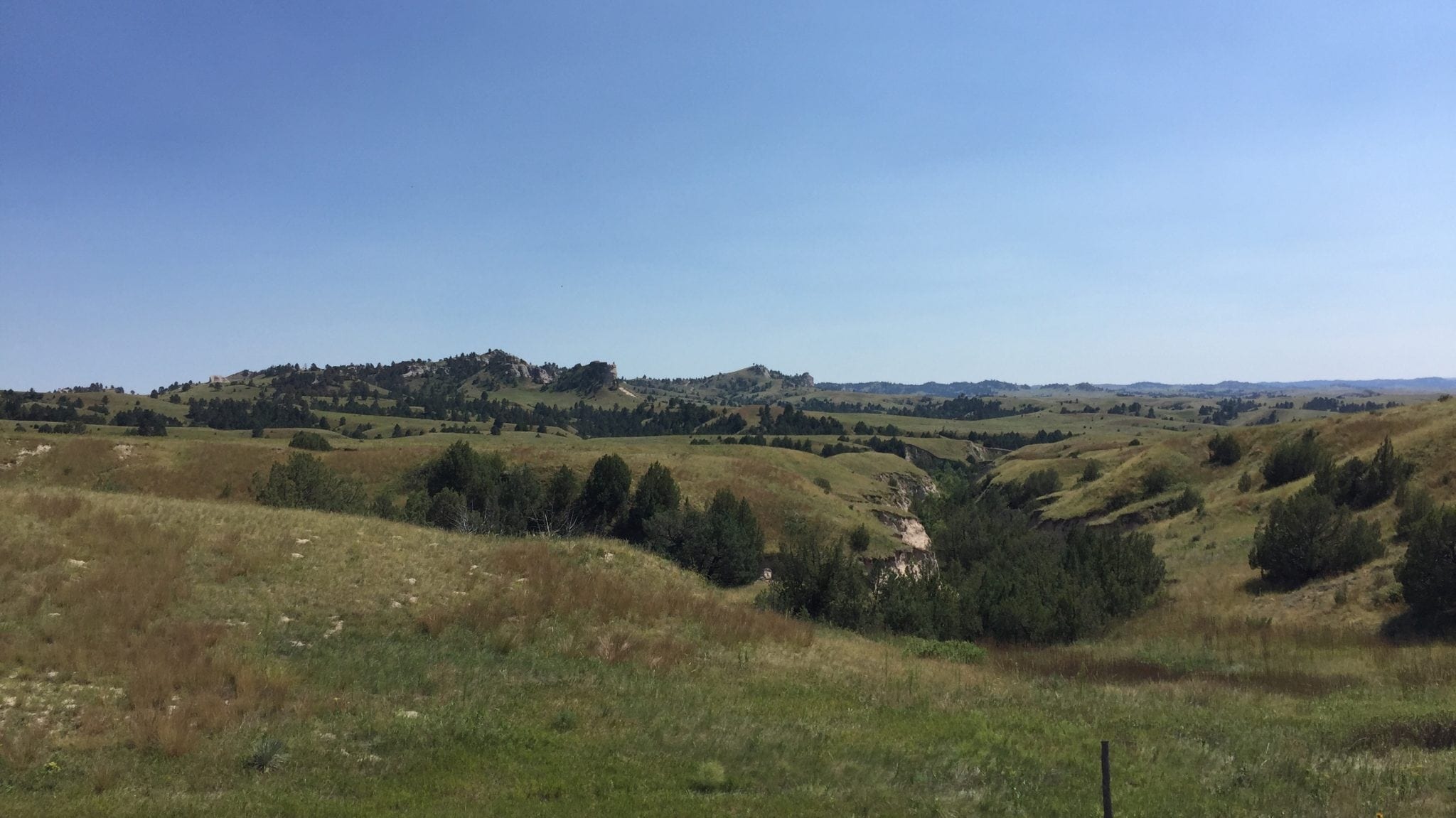
- Red wheat, sunflower, safflower are the 3 main crops on the Reservation. Who benefits from this? Not the people on the Reservation.
- Two years ago they finally lit path to boys and girls club. Thirty years ago they lit the road to Whiteclay where alcohol is sold.
- The hospital was built, but without a call system and telephones.
- Invasive mold: There were 800 documented cases before HUD told them to quit counting, or HUD would quit giving funding.
- Only 1 supermarket on the Reservation for 90 miles. The tribe owns the land the grocery is on, but it is leased to a company out of Iowa. After a salmonella outbreak on the Reservation, it was learned the grocery store chain was taking expired meat from stores in Nebraska, repackaging it, and selling it here as freshly processed meat.
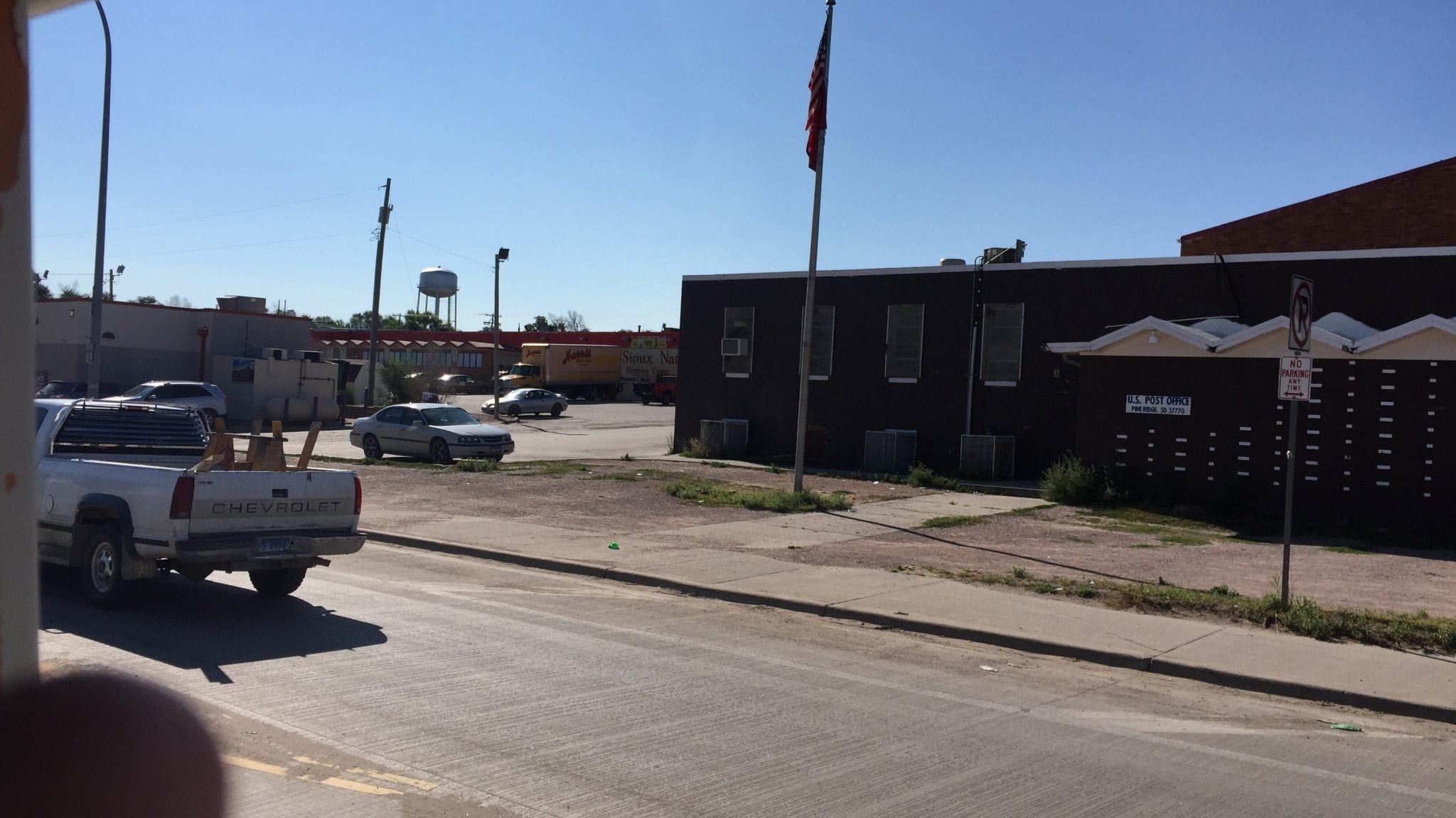
The store is in the middle of the photo with the yellow truck at it.
- Man from CA donated 50$K to build the skateboard park.
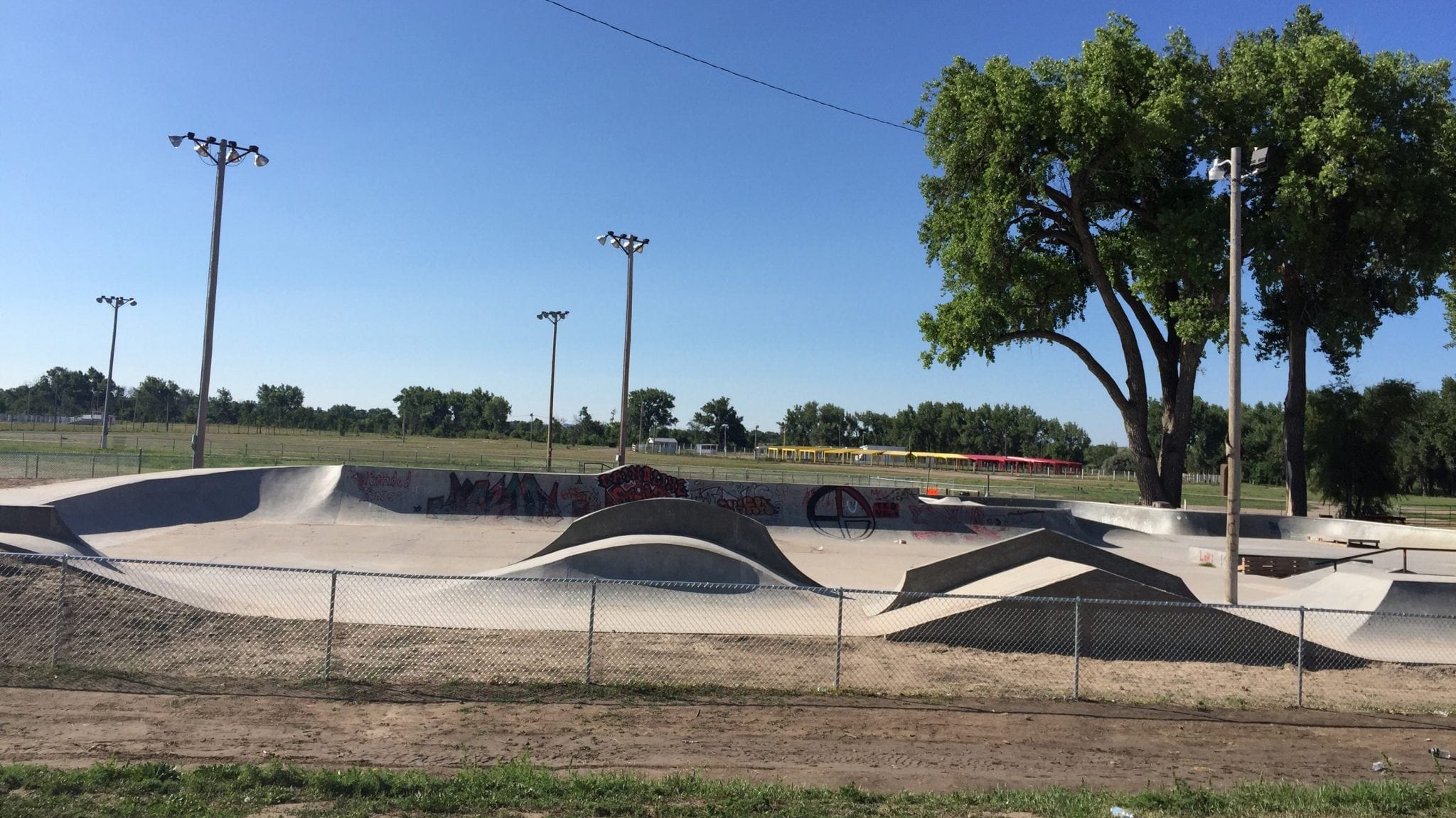
- Every reservation has a college center.
- 99% children receive free lunch at school.
- Pine Ridge Jim Thorpe
- I asked our guide if the historical trauma associated with modern schools using dorms left over from boarding schools was addressed. The answer was no. How would adults who had been in the system feel when dropping kids off at these schools!
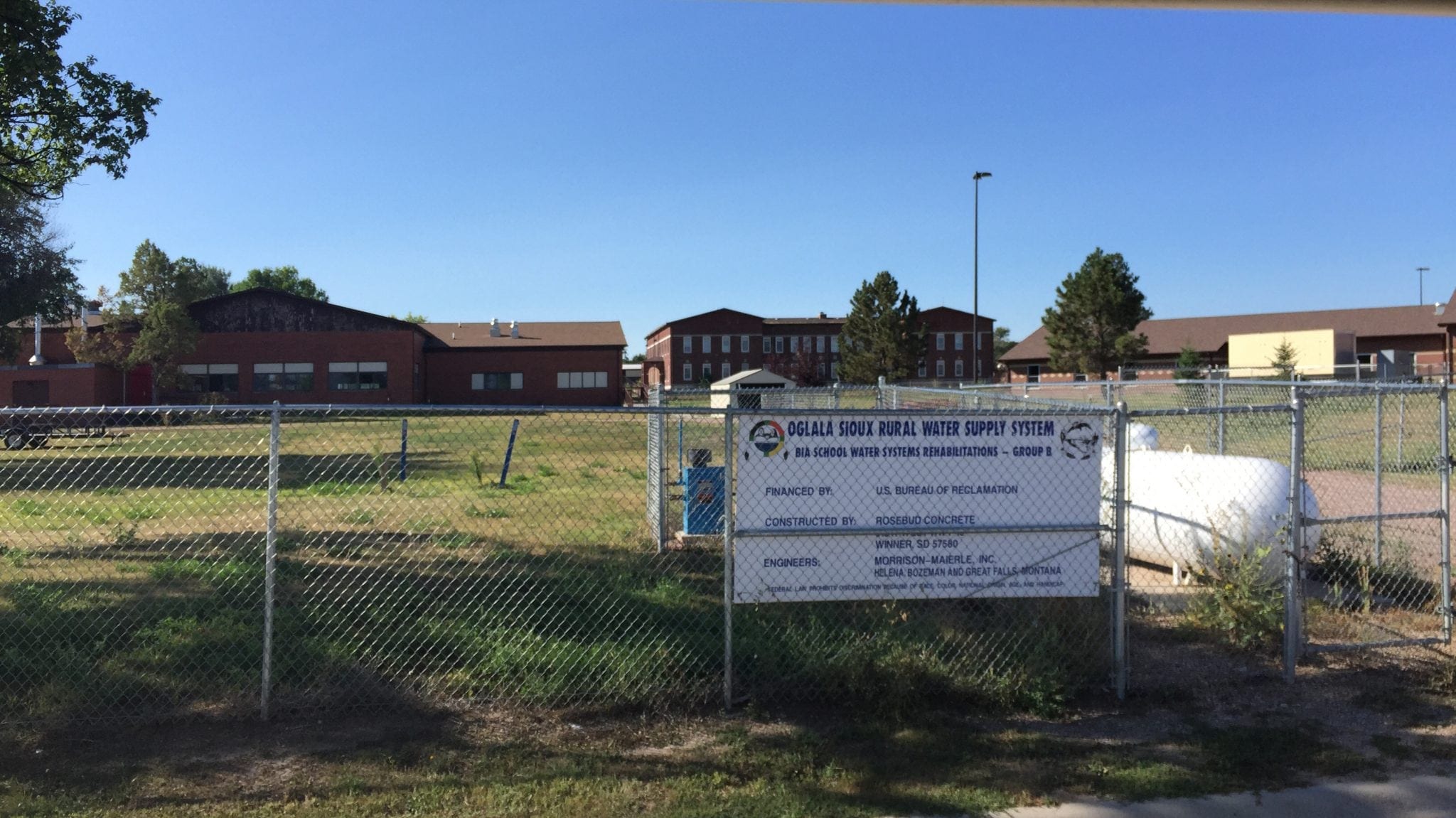
That is an old boarding school in the background. It is still used as a part of the school.
- Mills – gold medal winner
- Katrina FEMA trailers have formaldehyde in them.
- 89% unemployment – small business loans are hard to get.
- Carlyle boarding school, Chief Red Cloud wanted to form his own school on the Reservation – each reservation was assigned a faith this reservation was Episcopalian. Katherine Drexel, daughter of a devout Episcopalian Philadelphia philanthropist, worked with the Chief to make it happen. It is now the best school on the Reservation academically .
- 60 % local teachers – 95 % are native – 98% grad rate – 94% to college – other 6% to military or workforce ~ Bill and Melinda Gates scholars – Admissions test at Red Cloud – 600 students total 200 at each level. 50 – 70 % graduation rate at other schools.
The church below is across the street from the school, and these are our wonderful guides, home for the summer from Stanford. The church was lovely, but I couldn’t stay in it. After everything we heard and witnessed, and then to see the most beautiful building on the Reservation a church. It all felt like the worst sort of hypocrisy to stand in this church and discuss its beauty. Too much was stolen from these people in the name of religion, progress, and democracy for me to appreciate it at all.
- Custer told the Lakota they had to go to their reservation, but they were already at their reservation.
- Bobbi Red Cloud, great granddaughter to Chief Red Cloud, at the Red Cloud Monument (that’s our bus in the bottom photo)
- Bettie’s Kitchen where Black Elk Speaks was transcribed and spoken., http://www.amazon.com/Black-Elk-Speaks-Premier-Edition/dp/1438425406.
- Manderson is a town where the hill is moving, so the windows cannot have screens on them, because the houses are becoming tweaked.
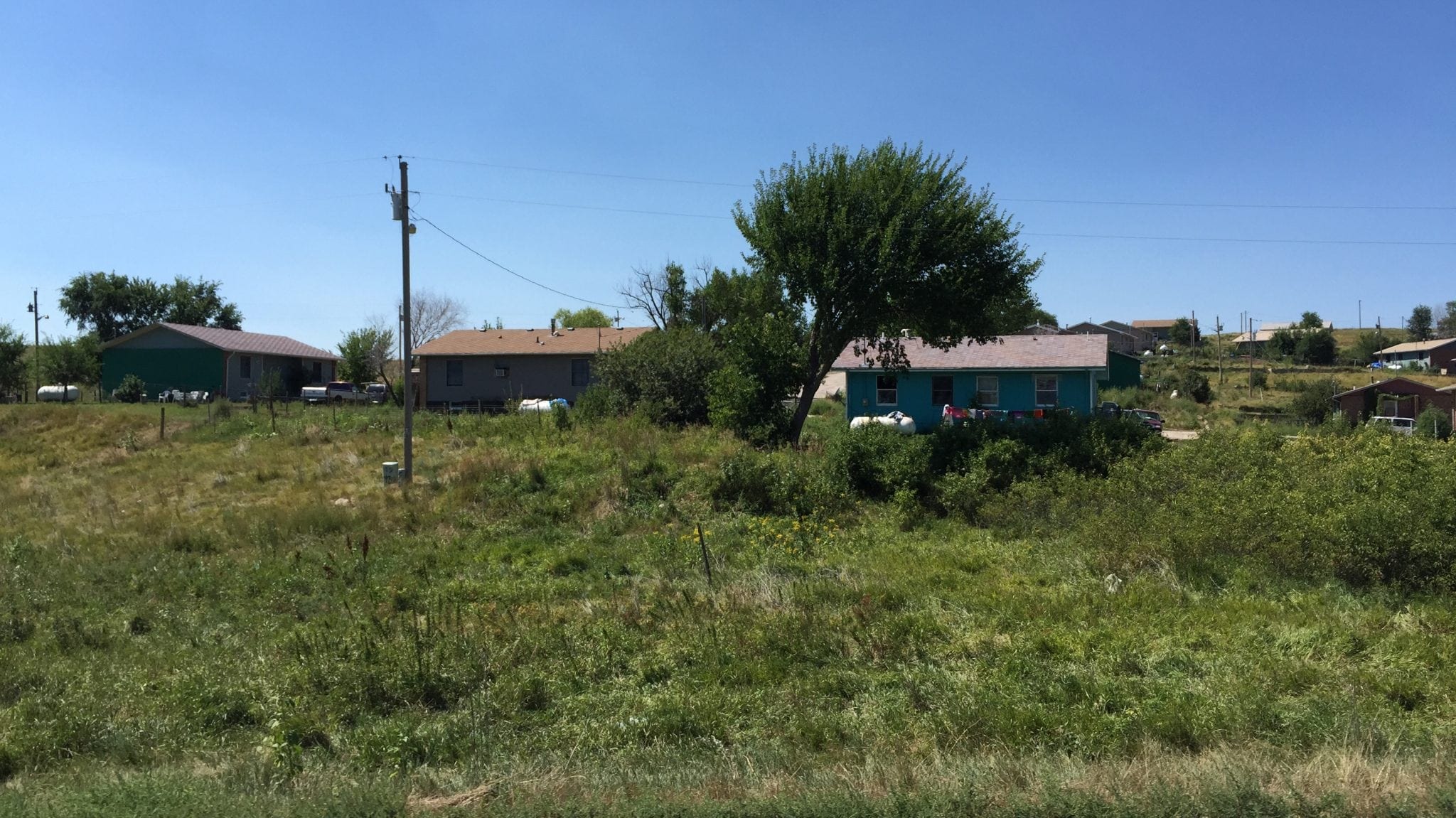
- Timpsula: “Timpsula was probably the most important wild food gathered by Native Americans who lived on the prairies. In 1805 the Lewis and Clark expedition observed plains Indians collecting, peeling, and frying it.” http://www.manataka.org/page827.html
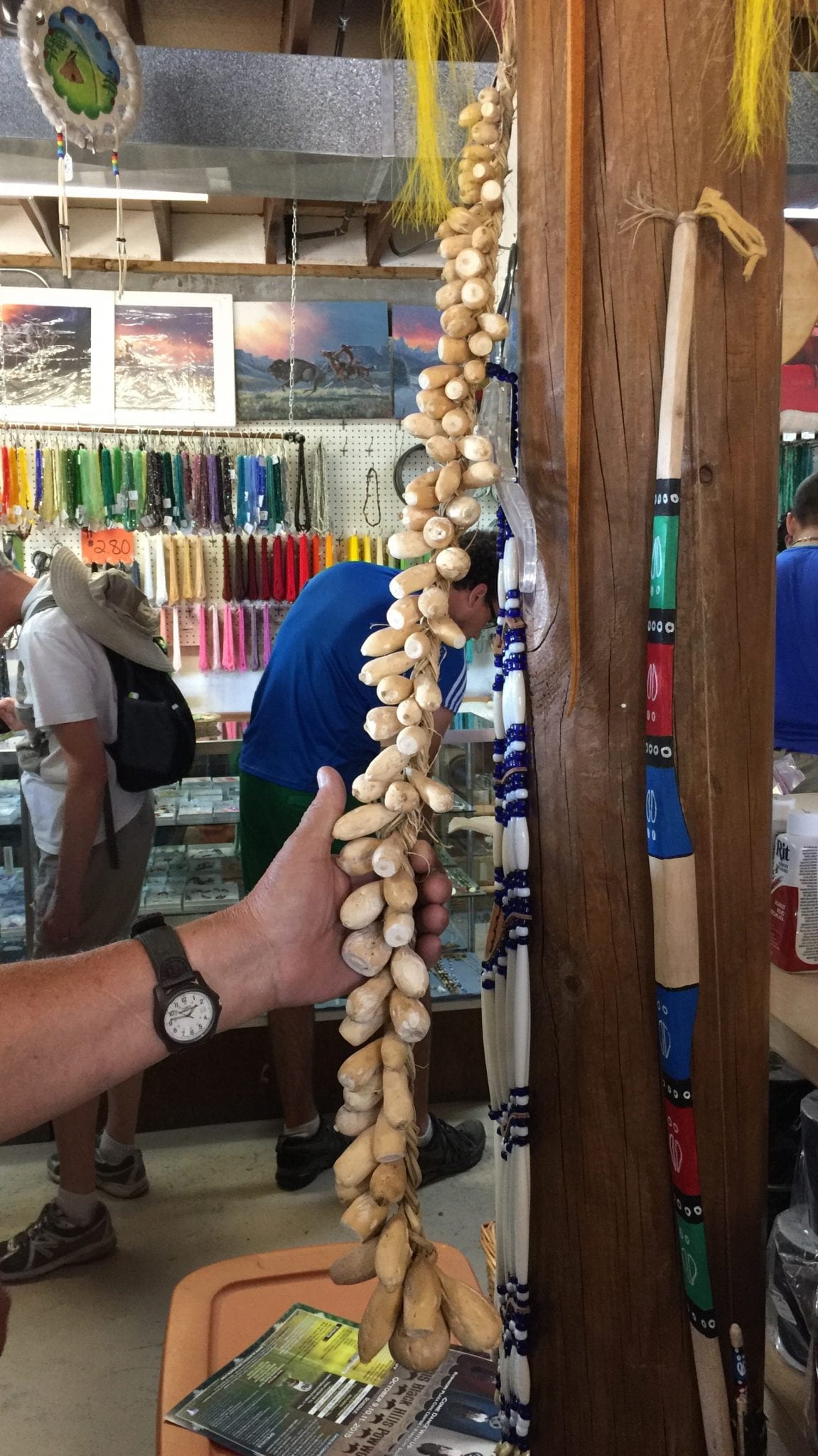
- These were in a museum that is down from the college.
We spent the evening saying our goodbyes. Michelle and I are saying goodbye to Paula Sibel, the trip coordinator at Re-Member.
8/21/2016: Depart Pine Ridge, Custer State Park: The Synthesis
When originally planning this trip, we intended to leave Re-member and drive to North Dakota to see some of Jim’s relatives or head right away toward Yellowstone. During the week I realized we were going to need some time to process what we experienced and saw at Pine Ridge. I did not spare us when I chose a location. We drove to Custer State Park in the Black Hills of South Dakota. I wanted all of us to see firsthand what had been lost. These are the Oglala Sioux’ ancestral lands that the Supreme Court agreed were wrongfully taken from them in their 1980 decision of the case the United States v. Sioux Nation of Indians. The Sioux tribes were “compensated” the paltry sum of 102 million dollars. I say paltry because now that I have been there, I know the land taken from them is stunningly beautiful, rich with resources, and verdant. Something the Reservation land the tribes were granted are not. 102 million dollars is not enough for this land. That is beside the point however, because the tribes won’t take the money and it has sat in an escrow account since. The tribe will not cash the “check” even though they could obviously use the money. This is a serious matter of principle for the tribe. The land was never for sale, and they feel if they take the money it will be tantamount to a sales transaction. What they want is the Black Hills back. After visiting them I understand why. This is a part of the Lakota’s historical trauma. The Black Hills that were taken from them need to be viewed in this context. That is what the four of us did.
For much of the year leading up to this trip we had been hearing the term white privilege. We had been hearing it said by some that all white Americans are inherently racist because of this privilege. Sean and I had read Between the World and Me by Ta-Nehesi Coates. The book resonated with two of us. On the Reservation white privilege, and what it means for people who don’t have it, was everywhere.
Sean’s Processing
I think the real problem is ignorance, indifference, and greed. I think these three things have led to the situation on Pine Ridge. It is impossible to deal with greed. There is nothing to be done about people who choose not to care about others and who take advantage of them for money. The people motivated by greed look at other people as opportunities for becoming richer. They don’t care about helping people or doing the right thing, so they won’t change. If doing racist things helps them get what they want, they will do them. If using racism gets other people to give them what they want, they will use it.
I think part of the reason people are indifferent to these problems with racism is they feel they are the ones being blamed. They feel things like, “I didn’t kill Native Americans or make them impoverished.” The reason this works so well is because it is true. I believe the best way to get people to think about these issues is not to tell them the horrible things “white people” did, but to make them think about the horrible conditions Native Americans live in now and the fact that they could be helping.
I think all these problems are not of a single man but that of our culture. Our educational system teaches us lies about Native Americans. Many people are raised to care more about others inside of their social group. The problem is when we care about our social group and not all humans we give benefits to our group and are indifferent to people in other groups. When people are indifferent because they only care about others like themselves, their indifference is a big part of racism. In order to fix these problems we need a generation of different thinkers, thinkers who refuse to be indifferent about the plight of others.
There need to be politicians who legitimately care about the issues of the Native people. I left feeling that most politicians do not care about Native Americans, life on the Reservation, and the issues they are dealing with. I don’t believe these politicians are ignorant, so it has to be indifference and greed which translates into racist attitudes and policies.
The one thing, besides vote, we can do something about is ignorance. We can reach out to people who don’t know about this situation and hope by doing this people will start to care. I think there are a lot of people who don’t understand how bad it is for some Native Americans on reservations. It is important we start to educate people with the truth and not lies so they will no longer be ignorant about Native Americans and what life is like on reservations like Pine Ridge.
Sean Lee, Age 15
In the summer of 2016 my family will return to the Reservation and continue our education.
Check out our previous post on handcrafting high school here.


